MILLION
DePaul facing ‘historic’ budget gap; personnel cuts expected today
Students respond, act on behalf of faculty ahead of cuts
By Nadia Carolina Hernandez Editor-In-ChiefJessica Parker, a DePaul junior, decided to take action when she learned that impending budget cuts would impact adjunct and term faculty today.
Parker and others took immediate measures by starting a petition and planning a protest outside at noon today at the Student Center. As of publishing, 749 people have signed in six days. They are asking President Robert Manuel and the Board of Trustees to protect at-risk faculty.
“Religious organization professors can’t unionize,” Parker said. “They can’t protect themselves, which means that it’s our responsibility to do so.”
DePaul leaders project a $56.5 million budget gap for the 2023-24 academic year. The Strategic Resource Allocation Committee (SRAC), a group comprised of appointed members by the president, informed faculty before spring break that in order to make up for the difference, they would have to lay off term faculty throughout various
colleges.
Adjunct and term faculty are parttime faculty that are hired on a contract basis and do not have the same protections as tenured faculty.
Parker and fellow students Megan Galarza, Jessica Patrick, Gracie Crone and Katie Wiemeler realized an urgency to organize after hearing about impending cuts. Since Monday, April 3, they created a petition and started a Discord to connect with students. Paper QR codes linking to their petition were passed out across classrooms all last week.
The group said they were concerned that the job security of adjuncts and term faculty throughout the university could potentially be in jeopardy.
“Some of my favorite professors have been adjuncts,” Parker said. “I do think it’s basically like abusing contract workers, the way that universities treat adjunct professors.”
See PROTEST, page 6
Faculty: Decisions made hastily, without collaboration
By Patrick Sloan-Turner Online Managing EditorThe first 125 days of DePaul’s 202223 academic year came with hope for much of its community, as the arrival of President Robert Manuel was cause for celebration after disappointment with the previous administration. But underneath, a long-developing crisis brewed.

Above it all, the new chapter brought positivity. The university commemorated beloved staff members with DePaul’s 125 faces initiative. Leaders spoke with optimism of grand plans for the future.
When the celebration ended on day 126, inside a classroom of Munroe Hall, Faculty Council members were told of an early, still evolving figure that was a first glimpse into the university’s bleak financial reality.
Over the next few months, that knowledge would grow in spurts, as faculty leaders slowly learned of more factors that affected the school’s financ -
es over the past several years, leading to its current state.
Finally, at the beginning of the spring quarter on March 27, the scope of the situation was seen.
It was then that faculty ultimately learned the extent of a dire circumstance: that projections indicated DePaul’s expenses will outweigh revenue by $56.5 million in the 2023-24 academic year.
Decisions
“Faculty [were] lost about what’s happening,” said Marcy Dinius, a professor of English in DePaul’s college of Liberal Arts and Social Sciences (LAS). “Just fundamentally, [we] don’t understand why we went from such a rosy picture to suddenly ‘this is very dire, and we have to act immediately.’”
Typically, those tasked with DePaul’s budgeting process conduct eval-
See BUDGET, page 6
we know’
‘on a dime’
Legal Facts 2006
In 2006, the state passed the Illinois Human Rights Act, which bans discrimination on the basis of “actual or perceived heterosexuality, homosexuality, bisexuality, or gender-related identity, whether or not traditionally associated with the person's designated sex at birth.”
International Transgender Day of Visibility occurs amid states passing anti-LGBTQ+ legislation
 By Olivia Zimmerman Staff Writer
By Olivia Zimmerman Staff Writer
Chicagoans gathered at Grant Park on March 31 in support of the transgender and nonbinary community for International Trangender Day of Visibility.
This day was celebrated despite the increase of anti-trans legislation and rhetoric throughout the country. Currently, the American Civil Liberties Union (ACLU) is tracking 452 anti-LGBTQ+ bills in the U.S. Illinois is one of only nine states not passing any anti-LGBTQ+ legislation.
In 2006, Illinois passed the Illinois Human Rights Act, which bans discrimination on the basis of “actual or perceived heterosexuality, homosexuality, bisexuality or gender-related identity, whether or not traditionally associated with the person's designated sex at birth.”
Since this law was passed, Illinois has some of the broadest protections for the LGBTQ+ community, said Edwin Yohnka, director of communications and public policy for ACLU Illinois.
“There’s never been an issue, for example, in Illinois in terms of youth participation in sports if they’re transgender,” said Yohnka.
Yohnka said one of the most pertinent issues facing the trans community in Illinois is insurance companies not paying for trans healthcare.
“We’ve seen lawsuits around access to healthcare, where there have been medications where insurance policies will cover it for a prescribed use that isn’t related to transition care, but has then been denied for transition care. That type of issue [the ACLU] has been able to push back at the state level,” he said.
This law has not stopped attempts to discriminate against people in the LGBTQ+ community in Illinois.
Hazel Kay, a freshman who identifies as nonbinary, said that Chicago is a welcoming place for the LGBTQ+ community. Kay believes that misinformation about the trans community is one of the biggest issues the trans and LGBTQ+ community faces.
“I had an uncle who lived in a more rural suburb area, and he was very homophobic. Even that was uncomfortable, but he wasn’t particularly violent. The biggest issue is the rhetoric because that's where a lot of the violence starts,” said Kay.
2013
In 2013, the ACLU represented a student who was denied access to the girl’s locker room, and instead, had to change in a different area. District 211 was ruled to have violated Title IX, and had to end discriminatory practices. The ACLU sued the district again in 2017 for the same practices.
SOURCE | ACLU
High School District 211, which serves students in suburban Chicagoland, was sued twice for discriminating against transgender students. In 2013, the ACLU represented a student who was denied access to the girl’s locker room, and instead, had to change in a different area. District 211 was ruled to have violated Title IX, and had to end discriminatory practices. The ACLU sued the district again in 2017 for the same practices.
Backlash came swiftly, and in 2016 a group called Students and Parents for Privacy sued, attempting to reverse the order, to keep transgender students separate. In April 2019, the group dismissed the lawsuit.
“Obviously [the backlash] is part of a nationwide trend, we’ve seen anyone dipping their toe into the news has seen over the last few months the same sort of
arguments and the same sort of behaviors being displayed at school boards everywhere,” said Kim Cavill, a candidate for the District 211 board, and an incumbent since 2019.
Throughout the District 211 school board election, citizens groups such as Citizens 4 Kids Education (C4KE), Awake Illinois, and Parents for Privacy are vocalizing their opposition to the teaching of trans, nonbinary and LBGTQ+ material on their Facebook pages and websites.
C4KE ran ads against Cavill, who is also a former sex-ed expert and instructor, along with three other candidates. They also sent out flyers advocating against district policies and decisions protecting trans and LGBTQ+ students.
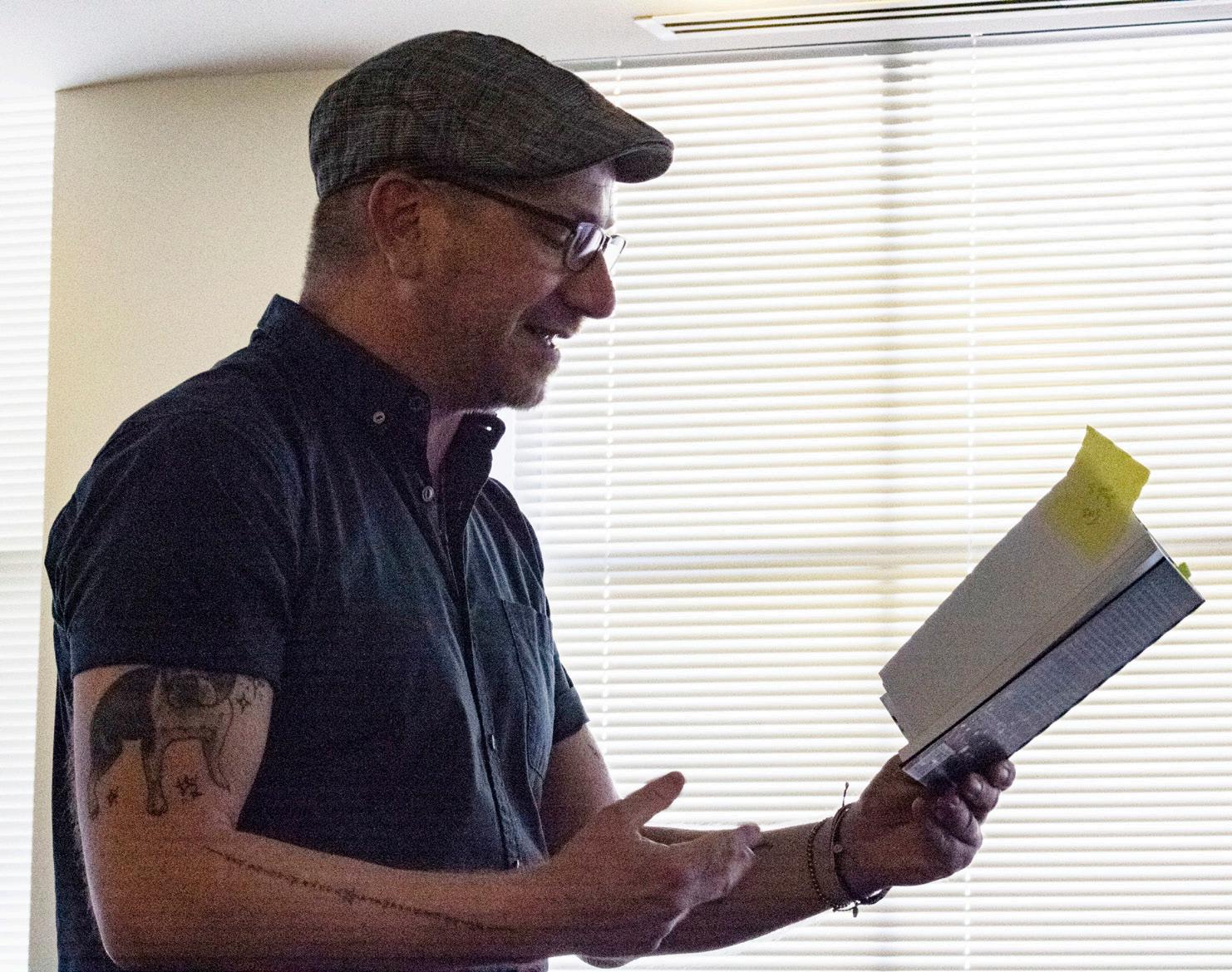
“There’s always a backlash to any sort of progress, and [since] securing the right to marry, we're still undergoing the backlash, and probably will be for some time,” said Cavill. “ When you look at cultural trends and the incredibly rapid pace [in which attitudes have changed] toward [the LGBTQ+ community] since Obergefell [was decided], it doesn’t really work anymore as an electoral strategy. You need a new villain.”
According to Cavill, political groups are using anti-trans rhetoric to further their political agenda. She said this is because the trans and nonbinary community is much smaller in number than the LGBTQ+ community.
Backlash against the trans community has been targeted against a suburban bakery, according to reporting done by NBC Chicago. Uprising Bakery and Cafe in Lake in the Hills, became a welcoming space for the LGBTQ+ community by hosting a drag brunch for families, and most recently, by hosting a party for Trans Day of Visibility.
According to Corinna Sac, the owner of Uprising Bakery and Cafe, local community backlash has increased.
“They’re calling the health department on us, now they’re going after us saying that we’re laundering money, they’re calling the IRS on us, they are calling the Department of Labor and saying that we’re not paying our employees or that we’re paying them under the table,” said Sac.
Sac believes that one of the biggest issues facing the trans community currently is disinformation.


“We’re in a very conservative area, so [disinformation] is very, very prominent here, and that’s why [transphobia] is taking such a hold out here. There is so much disinformation being spread about trans individuals, about LGBTQ in general, but really targeting [the trans community]. Not just adult trans [people], but specifically minor LGBTQ [people],” Sac said.
To Yohnka, involvement on a local level in communities is important.
“What we know in Illinois, and especially in the suburbs, is that yes, there are pockets of virulent anti-trans feelings and actions,” Yohnka said. “They are not the majority. I think the fact is because we have the law on our side, if we also have the right amount of citizen participation, I think we're going to be able to push back against these kinds of concerns.”

'We come alive' Youth turnout secures Johnson’s mayoral victory
By Kiersten Riedford, Jacqueline Cardenas, Nadia Carolina Hernandez News Editor, La DePaulia Editor-in-Chief, Editor-in-ChiefChicagoans voted Brandon Johnson to be the city’s next mayor on April 4. The increased turnout of youth voters pushed Johnson to his win.
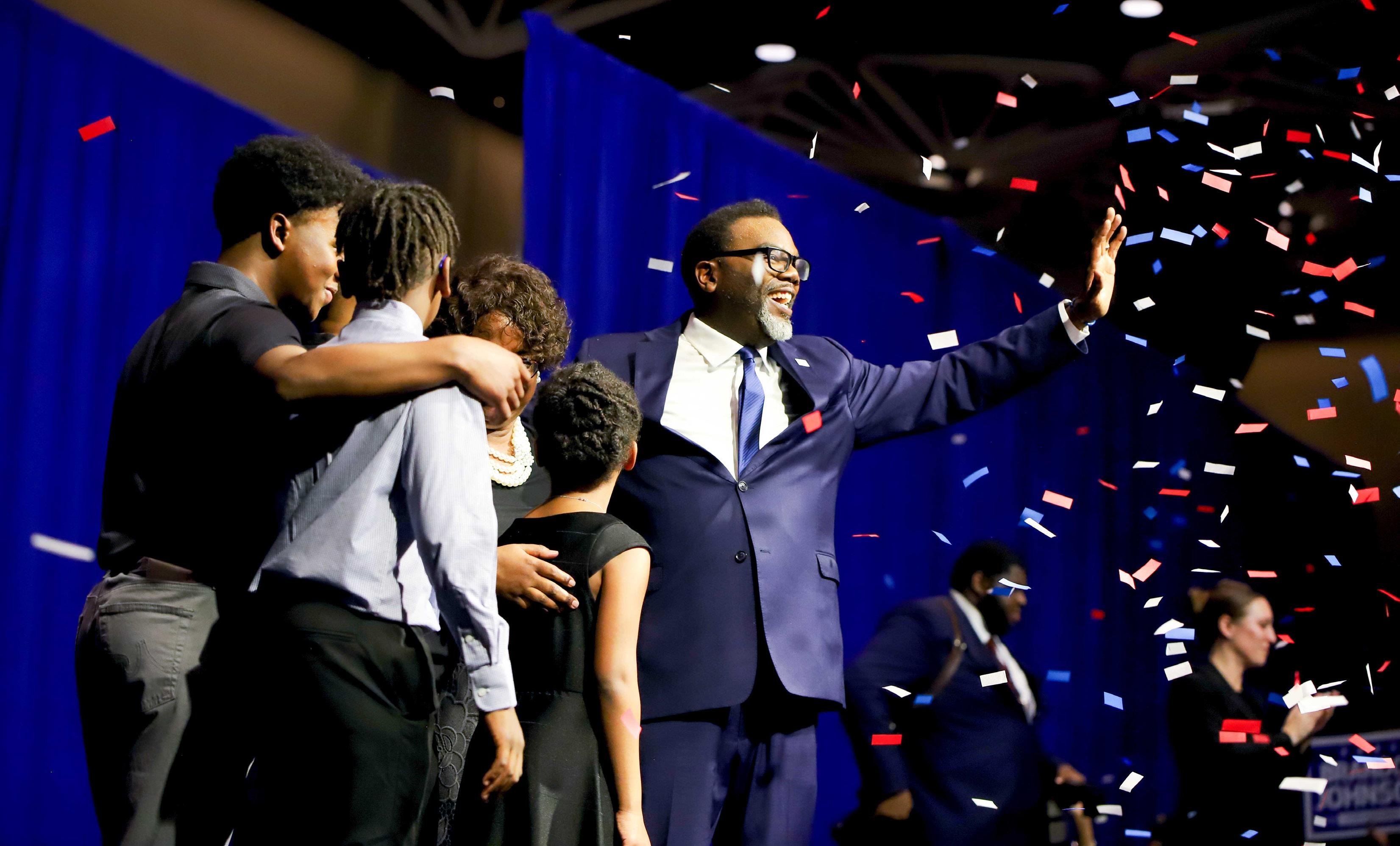
Youth voters ages 18 to 24 years old had the largest increase of turnout for the runoff election. In the primary election on Feb. 28, this voter demographic made up only 3% of the votes, according to the Chicago Board of Election Commissioners.
In the runoff election on April 4, 18 to 24 year olds’ votes increased by over 5,000 making the turnout by the youngest age group jump to 4% overall in the race. In this voter age group, they increased votes by 32%.
These 5,000 votes contributed a large amount, especially considering how Johnson only beat his opponent, Paul Vallas by 20,213 votes, according to the Chicago Board of Election Commissioners.
Johnson said in his victory speech on Tuesday that many doubted his ability to land the role, especially after Vallas finished first in the primaries.
“But now they know!” Johnson yelled out to the crowd at his victory party. The audience consisted of voters around 50 years of age and younger.
Johnson and Vallas’ election parties had contrasting differences surrounding celebration festivities.
Johnson was blasting DJ music, and at one point, the fourth floor event room in the Marriott Marquis Hotel was shaking from so many attendees synchronously dancing to the Cupid Shuffle.
Vallas’ was a cocktail party that had a bagpipe player filling silent pauses.
Ultimately, while the voter turnout was a large proponent of the race, winning
boiled down to two main points: education and public safety.
Education
Vallas’ education platform insisted that standardized testing should be prioritized, according to WBEZ. In regards to budgeting for schools, Vallas planned to let principals and local leaders’ have power over CPS spending and programming.
Johnson led with a different approach. Instead of trying to tackle test scores, Johnson told WBEZ he plans to guarantee “a baseline of resources for every school.” He said his priorities lay with ensuring all neighborhoods, especially those in poverty, can offer students a well-rounded and quality education.
“With so many people in the city of Chicago, we recognize value,” Johnson said at his victory party when referring to the underfunding of CPS. “But so many of us don't believe that we deserve it. That changes under a Johnson administration.”
Johnson’s values appealed to many, especially those within the 18 to 24 year old category since most are either in school or have recently graduated.
“I think every kid in the city of Chicago should have quality education no matter how much their parents make,” Danaka Kacopich, a Johnson supporter, said.
Many teachers aged below 50 years old sided with Johnson, mainly due to his experience as a CPS middle school teacher prior to serving as a member of the Cook County Board of Commissioners. His role in CPS made a lot of voters, like Yasmeen Ibrahim, a DePaul sophomore in environmental studies, feel like Johnson could relate to Chicagoans better than Vallas could.
“I think it's significant to note that Johnson used to be a public educator in Chicago,” Ibrahim said. “He has truly served Chicagoans time and time again, and I'm sure he will as mayor.”
To Vallas supporters like Kadin Red, who bounced around to several Chicago schools in his time as a student, making sure that the funding is allocated to the correct places is important because “public school specifically is just severely underfunded.”
“It was hard for me to learn because it almost seemed like the teachers didn't really care to be there,” Red said. “I definitely think [there should be] more care [and] more attention to the schools, the teachers that are put in those schools [and] the principals that are put in charge of those schools.”
Avery Schoenhals, Student Government Association (SGA) EVP of Facility Operations and sophomore, said that he sees Vallas as “a wolf in sheep’s clothing.”
“He’s said himself that he’d run as a Republican,” Schoenhals said. “He supports the privatization of public schools. I come from a family of teachers, and supporting public schools is an issue that’s a top priority for me. That’s why I’ve supported Brandon Johnson since before the initial election back in February.”
Schoenhals said now that Johnson has secured the mayor-elect position, he is “feeling proud and excited for the future.”
“Investments in education, improvements to the CTA and public safety, inclusive policies, affordable housing, and better healthcare in our city are all things that were on the ballot this year,” Schoenhals said. “I believe Brandon Johnson will deliver on these issues and I’m proud to be a Chicagoan tonight.”
Safety
"Let me tell you what every mother needs in this city," Stacy Davis Gates, president of the Chicago Teachers Union and executive vice president of the Illinois Federation of Teachers, said on stage at Johnson’s victory party. "Every mother needs you to fight for safety so my child can be safe on the Red Line and the Green Line."
Many Chicagoans like Yarkona Hall, Johnson’s first cousin, said they have seen safety drastically decrease over the years. Hall said, as a woman of color, she no longer feels safe walking in the city, especially walking alone.
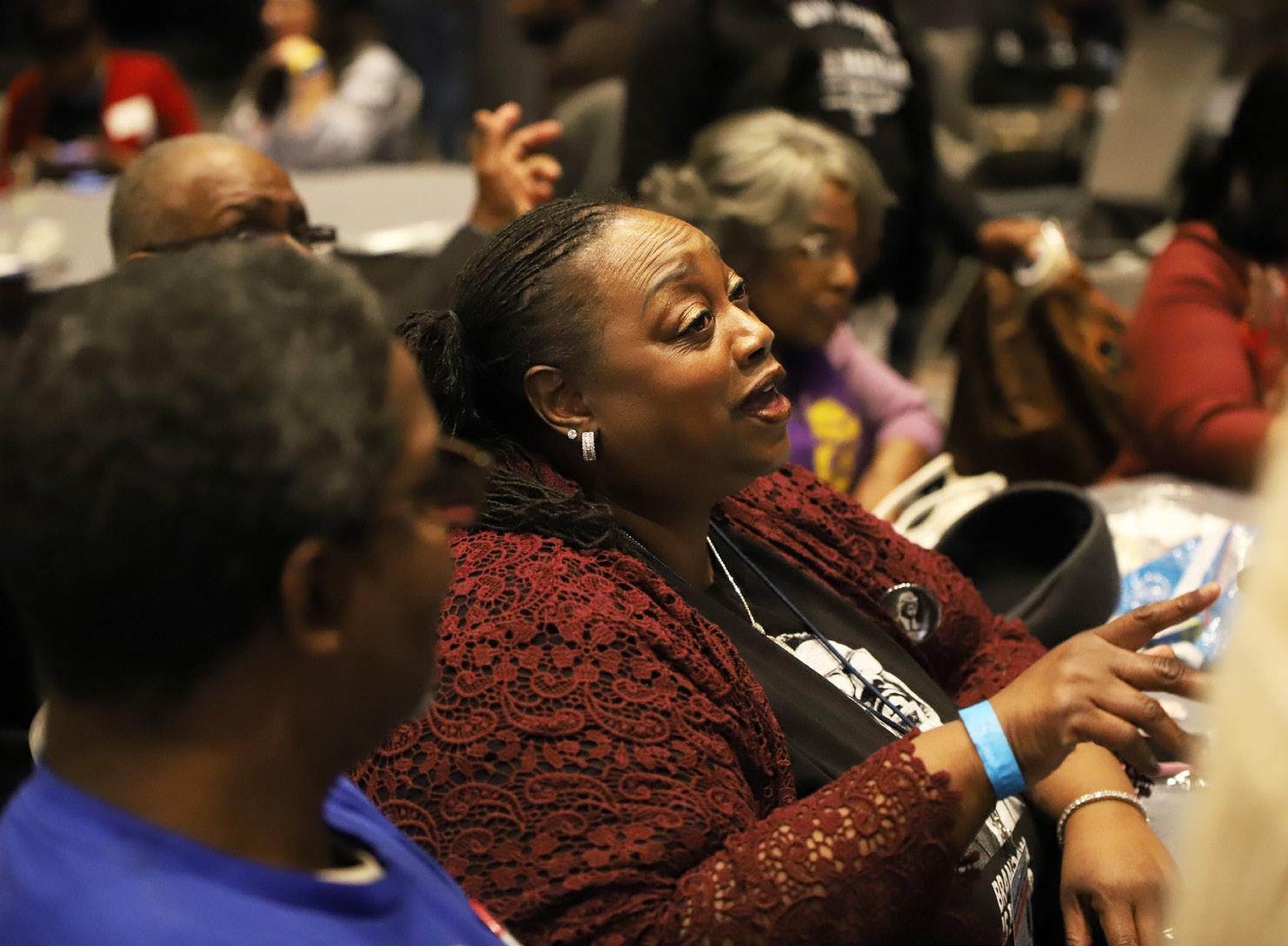
“I miss walking on the lakefront,” Hall said. “We just got to the point where I just didn’t feel safe.”
Hall said even though Chicago is in a
Yarkona Hall
spike of crime, she is optimistic that the city will change for the better under her cousin’s administration.
Many Vallas supporters, like Mike Fryzel, also want crime to decrease, but they tend to prefer higher police presence as a solution.
“Paul and I grew up in the same neighborhood in Chicago, Roseland community on the far South Side,” Fryzel said. “So we are familiar with what he's talking about [when he says he wants to get] police back out there, because that's the way it was when I was younger.”
Fryzel said the neighborhood he and Vallas grew up in frequently had “police walking up and down the street.” Fryzel said Vallas’ approach appealed to him because, from his experience, that was what he knew worked in his community.
Many Johnson supporters strongly disagree with needing more police presence to boost safety in the city. Ryley Albright, a DePaul alum who canvassed for Johnson’s campaign, said he prefers Johnson’s values of investing “in the people and not the corporations and police.”
Ibrahim said that his desire to invest in impoverished and marginalized communities means that Johnson's “ready to protect and promote the rights of people of color.”
“A value I like about Johnson is his willingness to actually confront issues,” Ibrahim said. “I'm appalled by [Vallas’] call for the increasing of the police force, especially in a city where marginalized communities have historically and to this day have been habitually mistreated and abused by police.”
Ibrahim said some citizens may believe extra policing will increase their public safety, but they believe “it would just cause more fear and harm for many others.”
Many Johnson supporters, like Hall, are excited to see safety increase over time under Johnson’s administration.
“He wants a better Chicago, and I’m so excited because I want a better Chicago,” Hall said.
What’s Next?
Many Chicagoans, like Laura Stream, DePaul sophomore and active member of the university’s unofficial Rise Up 4 Abortion Rights chapter, are anticipating an increase of confidence in the city’s safety, education and Chicagoans’ quality of life once Johnson takes office.
“Before the election, I was speaking to friends,” Stream said. “They expressed how they believed Paul Vallas would win, because he represents wealthy white men. Not because they wanted him to win or voted for him. They simply have lost faith that their vote matters, when status and wealth can mean more than actual qualifications.”

Stream said that after the election of Trump, “people have lost hope in our system of democracy.”
“Brandon Johnson’s win brings hope and confidence back to people,” Stream said.
Hall said she is looking forward to seeing Johnson’s administration make Chicago regain its sense of “togetherness” that the city is now lacking. Hall said Johnson “has a gift of making everyone
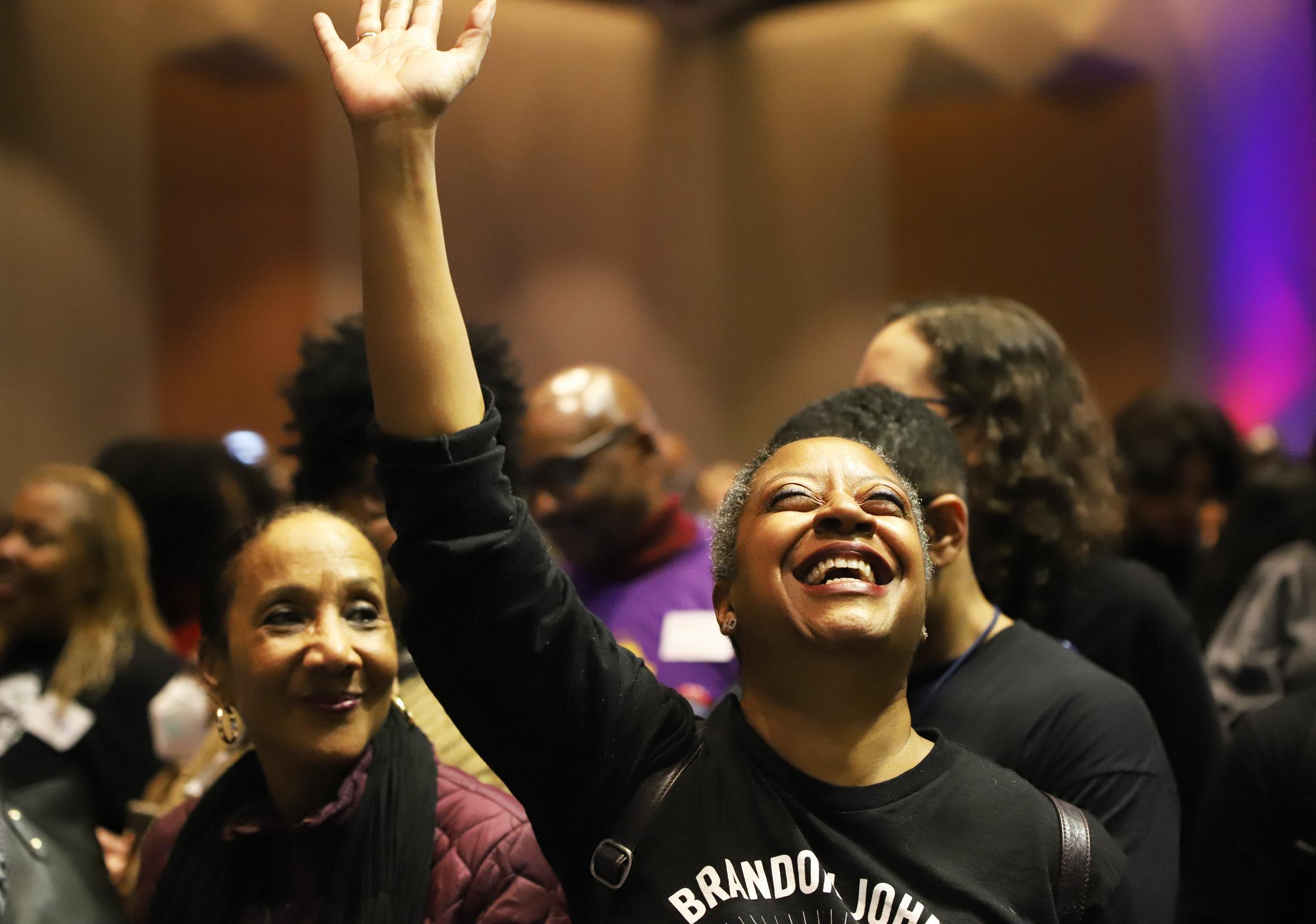

feel connected,” and he has always been that way.
“You cannot be around Brandon without changing or becoming better,” Hall said. “It’s the essence of who he is.”
Hall said she knows Johnson will try to care for everyone in Chicago in any way he can because that’s the type of person he is.
“That’s our family legacy,” Hall said.
“We can't just think about ourselves, it’s
not in our DNA.”
QUENTIN BLAIS | THE DEPAULIA“You cannot be around Brandon without changing or becoming better. It’s the essence of who he is.”Brandon Johnson's first cousin just Johnson will be sworn in as mayor of Chicago on Monday, May 15 at City Hall.
Clarissa Worcester, a DePaul women and gender studies (WGS) student, became involved because they believe adjunct professors in the WGS program are “going above and beyond.”
“All of them hold parts of the program that have increased the quality beyond the base curriculum of a general women's studies program, they hold the queer theory, they hold the disability justice programs,” they said.
However, if laid off, these programs would cease to exist without faculty to continue these certificates, according to Winifred Curran, a geography professor in DePaul’s college of Liberal Arts and Social Sciences.
“If you lose, you know, the one person who does blank, then that's it,” she said. “No one else is a specialist in that thing. You can't tell a historian of Latin America to teach Chinese history right. That is going to affect [the] student experience.”
Within the English department, adjunct and term faculty are teaching classes focused on marginalized voices, which Parker does not want to see disappear from the curriculum.
“Several of the professors that are doing the hard work of teaching Queer stories or teaching African American literature in the English department will qualify for the layoff program, so we could lose those professors either way,” she said.
Student Government Association (SGA) president Kevin Holechko serves as a representative on SRAC. Due to cuts being spread across two years, Holechko said this decision would minimize any potential impact on the student experience.
“If they had done it in one year, that would have affected the student experience,” Holechko. “They're spreading out across two years to make sure there's no disruption to a student's academic experience.”
However, there is no “guarantee” that the cuts will not affect students, according to Holechko. Students will most likely notice staff cuts in the next academic year.
“If there will be a noticeable effect, it may be in morale across the university,” Holechko said. “But where students will see potential physical differences are people in an office anymore.”
Holechko also addressed what he calls “misinformation” about budget cuts being spread across the university and says faculty and staff do not fully understand the context
of the issue.
“The faculty and staff are also just not fully aware of the budgeting process, and that is really to no fault of their own,” Holechko said. “People [need to] start explaining to students, staff and faculty that's not necessarily true. That's the responsibility of the leadership team to be transparent.”
According to Worcester, the only present accuracy issues regarding information lie in a lack of transparency from the administration based on a timeline.
“It's just not possible that it needed to be this urgent and surprising,” Worcester said. “This isn't a crisis that appears overnight in a budget.”
A source in LAS wrote in a statement that faculty are being left in the dark as well.
“Of many concerning things in this current round of budget cuts is that these moves to make cuts are happening very quickly, and there is little transparency as to where the 'hemorrhaging' is coming from, and why,” she wrote.

Curran echoed that attitudes about the budgets switched quickly from “not great” to “impending doom” around spring break.
Throughout all the chaos of the last week, adjuncts and term faculty continued to grade papers and teach classes through anxiety centered on uncertain job security come Monday.
“To be told that you're potentially losing your job while you are doing all of that is really soul-destroying,” Curran said. “Because of this deadline, they're kind of the ones who have been sacrificed first.”
Holechko said he recognizes staff will be hit the hardest by these cuts.
“My heart goes out to them because they don't have the same protections that a faculty member does,” Holechko said. “[SRAC believes] in the best interest of the institution, this is the pathway forward.”
Zayne Humphrey-Taylor, a WGS gradu-
ate student, wants to remind the community of the significance of adjuncts and term faculty in the DePaul academic community.
“They might read your papers, but they are our mentors, they are our advisors,” Humphrey-Taylor said. “They are sometimes the people that we want to emulate in the future.”
A source said that DePaul has to reflect on being a religious institution.
“As a Catholic University, an ethical and moral question regarding the Endowment is necessary,” she wrote. “The U.S. government requires a certain percentage of university endowments to be spent legally; but this is a long story and the percentages that meet the requirement of the law have not changed in years.”
Humphrey-Taylor is motivated to act on behalf of DePaul’s core values.
“It completely goes against the Vincentian question of what must be done,” HumphreyTaylor said. “None of this has to be done. They know their budget, we would like to see their budgets. Those of us opposing these cuts know what actually must be done.”
uation of a following year’s budget in the school’s fall term. According to an email from Faculty Council president Sonia Soltero to council representatives, this process was pushed to the 2023 winter quarter due to more recent financial concerns centered on 2023 that demanded the Strategic Resource Allocation Committee’s (SRAC) attention. Because of the delay, SRAC’s window to evaluate the budget gap and draft strategies to close it shortened.
At the end of March, SRAC detailed the $56.5 million shortfall and informed Faculty Council representatives of where cuts would come and how much would be cut from respective areas. Cost-saving measures were broken down between faculty, who will need to cut $11.3 million; staff, who are tasked with cutting $28.3 million; and departmental expenses of which $16.9 million will need to be cut, according to the March 27 Soltero email.
Included in faculty cuts is personnel actively teaching at DePaul. Today, around 3% of DePaul’s term faculty (non-tenured, full time professors) will learn they are being cut from the university budget, according to Soltero, who told The DePaulia “most of the budget cuts around people are going to be done through vacancies,” meaning that cost saving is first directed towards not filling currently empty roles.
April 10 was the pre-decided date for decisions on term faculty contracts, and while faculty leaders like Dinius had to make personnel decisions by today’s date, they didn’t know the full extent of the gap until March 27. She says $33.1 million of these cuts is coming from academic affairs, according to the only information given to faculty from the provost.
This means more than half of the total cuts for the next fiscal year will come from academic operations that includes faculty salaries, department expenses and student affairs, according to information she received from the provost.

“We can't make decisions like these on a dime,” Dinius said. “60% of this budget cut is happening through the very part of the university that is supposed to try to make these kinds of decisions on a much longer timetable, and with much, much greater deliberation, and certainly with much more information than any of us had been given.”
With a seat at the table on SRAC, Soltero spoke to The DePaulia on the concerns felt by faculty regarding the short window and the ensuing stress surrounding tough decisions that now must be made.
“The timing constraints, we really can't do anything about, and that's why people are so upset because they're right to be,” Soltero said. ‘We [on SRAC] have said that we don't have enough time to really do a deeper analysis where the cuts should come from.”
Dinius is not the only representative on Faculty Council who feels rushed and confused. On Wednesday, April 5, Manuel joined the first hour of a Faculty Council meeting and heard faculty’s concerns on the proposed budget.
“Most of faculty expressed [to Manuel] a great deal of frustration with how this is happening,” said Winifred Curran, a professor of geography in LAS.
Curran’s college, LAS, is the largest in the university, but she says it is also one that has seen the steepest decline in tenured positions over the past decade or so.
“We have been cutting for years,” Curran said. “Functionally, we have been cutting since 2008. It’s not like there is a lot of fat left over, certainly on the faculty and student facing side.”
Like Dinius, Curran shares a concern over the lack of transparency throughout this process. She says departments are being forced to make decisions that will affect people’s lives without having all the information, like the reasoning for specific dollar amounts being cut in certain areas.
"It's not just possible that it needed to be this urgent and surprising."Clarissa Worcester Women and Gender Studies student at DePaul
“It’s foggy, how these decisions are being made and how percentages are being decided,” Curran said. “Vulnerable people are losing their jobs when it’s not clear to us that it’s the best thing to do.”
It is unclear to faculty leaders of DePaul’s respective colleges as to exactly how many term faculty members will be affected in each department today, but communication obtained by The DePaulia indicates “colleges/schools with larger expected decreases in tuition revenue received a higher percentage target” in cuts.
As faculty like Dinius and Curran quetion the thought process behind the targeted areas for these impending cuts, they also question the ways in which DePaul has spent its money over the past decade. At Faculty Council meetings throughout the year, representatives have repeatedly posed the question of how DePaul got to its current financial state.
“One of the things that we're worried about is administrative bloat,” Curran said. “That there are more and more administrative positions now, and that we are spending as much money administering the university as we are in the actual work of education.”
Administrative bloat refers to the growing number of non-instructional jobs at universities and colleges that can be linked to the continuing rise in college tuition, as defined by the Martin Center for Academic Renewal. It is just one of many factors that has put academia in the place it is now.
Dinius echoed Curran’s worry that too much of DePaul’s resources have been pointed towards administrative costs and says faculty are wondering why more cuts are not happening at the top.
“The question has repeatedly been, why is so much of this coming out of academic operations, instead of from administration?” Dinius said.
A perfect financial storm
For more than a decade, higher education in the U.S. has experienced a significant decline in enrollment. Between 2009 and 2020, annual undergraduate enrollment decreased from 17.5 million to 15.9 million students, according to the National Center for Education Statistics.
Like most other institutions, DePaul has faced an enrollment decline too. Between 2017 and 2022, DePaul’s overall enrollment dropped from 22,769 students to 20,917, per data from DePaul’s Institutional Research and Market Analysis (IRMA). While steady, the decline demanded personnel change to reflect university makeup over the same stretch.
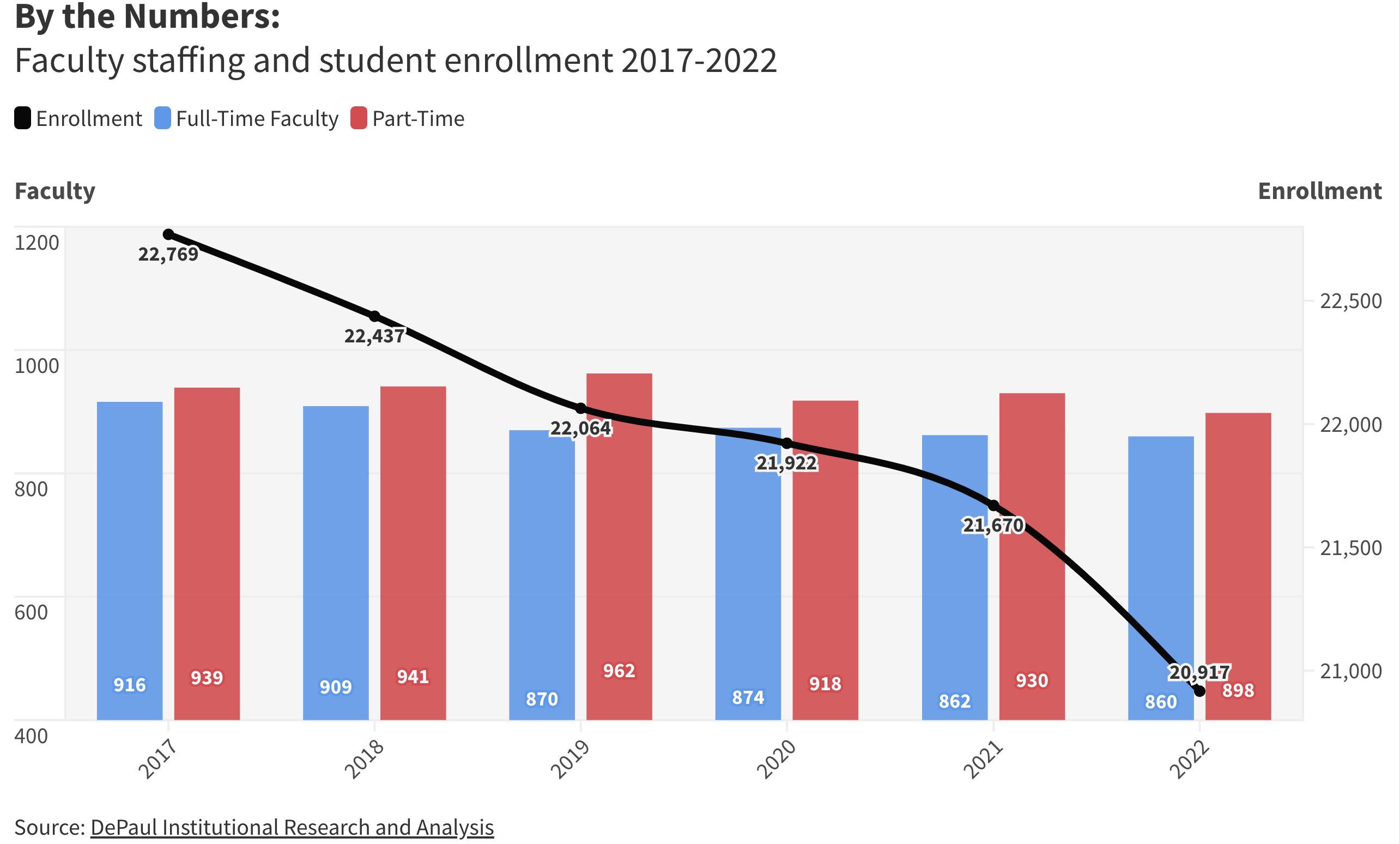
From 2017 to 2022, full-time faculty at DePaul dropped from 916 to 860, according to IRMA data. This is a sharp decline in educators, but the 6% decrease over the period does not appear to make up for the lost tuition revenue in the six-year stretch.
now react fast and cut expenses that include personnel, maintenance costs, student jobs, staff and faculty travel expenses and more to make up a gap of $56.5 million.
term faculty are announced, but she is “not aware of any departments or programs that will be dissolved.”
Ghanem also addressed faculty concerns surrounding transparency and a lack of involvement throughout the process.
“The university is committed to shared governance and transparency,” Ghanem wrote. “The budget proposal was approved unanimously by the Strategic Resource Allocation Committee which includes representation from faculty, students, staff and administration.”
The provost went on to say that upon its approval, the budget was “socialized” with faculty and units.
Still, faculty feel the extended period in which they lacked full knowledge of the situation’s gravity shows a lack of interest from administrators for faculty involvement.
“Instead of allowing us to help and do the work, we were forced to pound at the doors, trying to get in to help make good decisions,” Curran said.
Perhaps the biggest concern for those who serve on Faculty Council is the abandonment of shared governance throughout the process.
Dinius explained that things move slowly at a university and for good reason. She believes sweeping institutional changes require much consideration, in which all parties — faculty governance, staff governance and administration — have a seat at the table. Dinius says what has transpired thus far goes against the system in place that ensures equitable decision making.
“This is a significant institutional reorganization through the blunt instrument of the budget,” Dinius said. “And that's not how this is supposed to happen. It's supposed to happen through long-term planning and shared governance.”
Also, the 2010s saw costly building expansion on both of DePaul’s campuses.
“Bad financial decisions have been made in the past,” Curran said. “...We build new buildings, we spend a lot of money on athletics.”
Another significant ingredient for DePaul’s current financial crisis is the impact of the Covid-19.
At his State of the University address on Sept. 24, 2021, former DePaul President A. Gabriel Esteban addressed the financial hardship felt from the pandemic.
“Costs continue to rise, more students are foregoing college and public perception of the value of a college degree continues to wane," Esteban said.
At that time, DePaul received federal funding to help relieve some of its financial woes, but by mid-July 2022, the federal relief program expired, and DePaul was back on its own.
The complicated descent towards DePaul’s current state did not happen overnight, as the factors listed above paired with rising inflation widened a gap in revenue and expenses. For a process that churned slowly, faculty and administrators must
‘A statement of values’
With the cuts that are already underway and more expected to come, certain departments feel more vulnerable than others, not just in terms of losing personnel, but also risk of losing departments themselves.
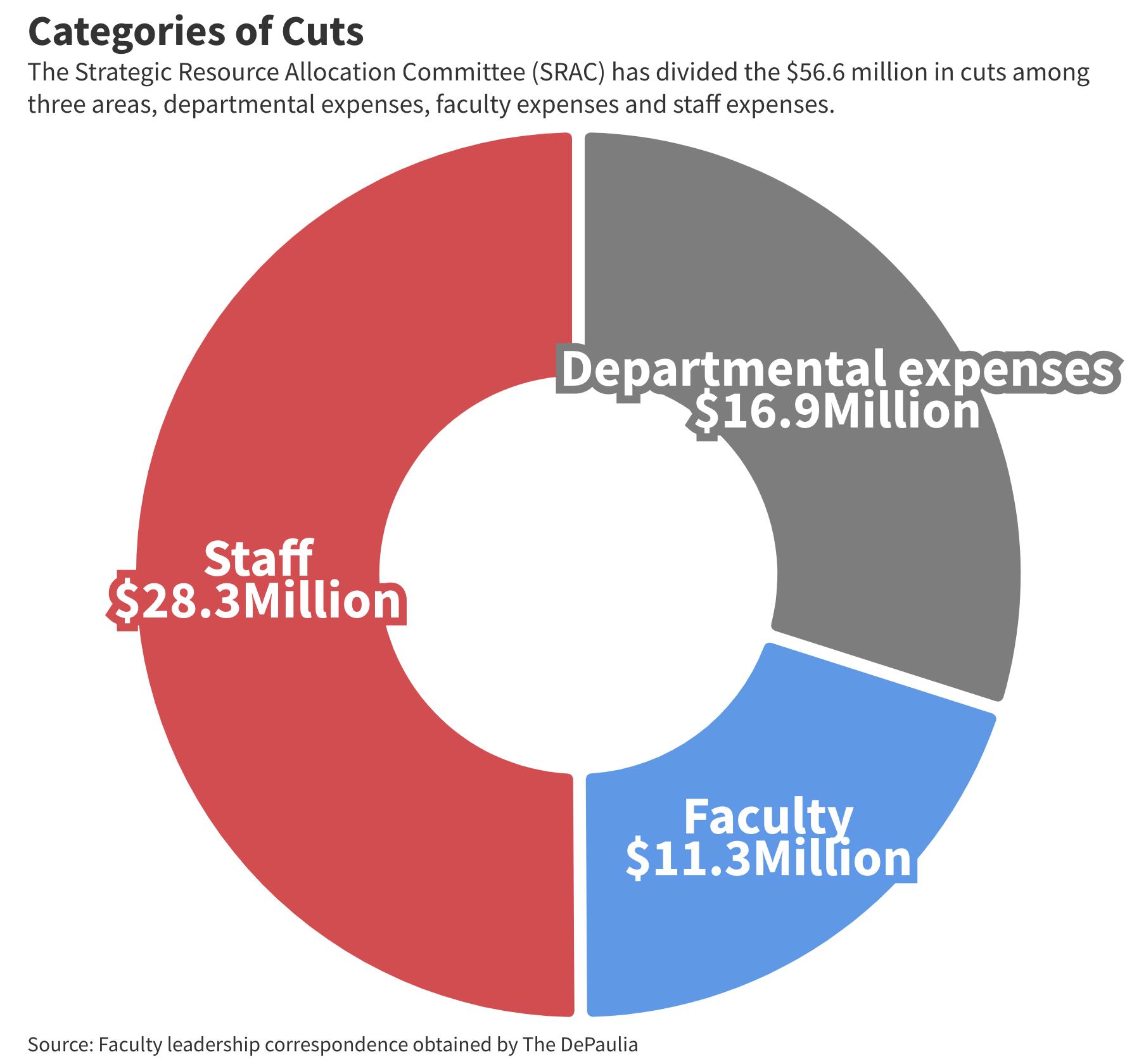
Dinius says that LAS includes several departments that represent marginalized students and marginalized topics of study, like women and gender studies, African and Black diaspora studies, LGBTQ studies and others who feel especially at risk.
“In several of those programs, you have a lot of courses taught by either part time or term faculty, and so yes, I think there's a real danger of losing programs like that,” Dinius said.
As a fellow professor in LAS, Curran feels this proposed budget lacks appreciation for smaller departments and the educations of which students in those departments receive.
“A budget is a moral document,” Curran said. “It is a statement of your values, and this budget doesn't value a whole lot about what we do.”
In an email to The DePaulia, DePaul Provost Salma Ghanem said that unit plans are due April 17, a week after decisions on
Thinking back to optimism felt as the academic year began, Dinius cannot help but feel disheartened with what has happened since. She said faculty have long felt a disconnect with the top end of the university in administration. Manuel’s arrival was an opportunity to rebuild that trust, but now it is hard for Dinius to not feel disappointed.
“We trusted that we had a much better partner in President Manuel, who came in with plans for growth and restoring trust between faculty and the Board of Trustees,” Dinius said. “We trusted our faculty SRAC negotiators, who helped lead the Council of the Whole.”
As faculty will lose their jobs today, the professor who is now in year 12 at DePaul, feels that any trust that was present has been betrayed by the lack of transparency throughout the process. Dinius said the events of the past few months have made trust and shared governance beyond SRAC impossible and erased some of the optimism that came with new leadership.
“All that trust has been replaced by very justified disappointment, frustration and resistance,” Dinius said.
PATRICK SLOAN-TURNER | THE DEPAULIA"A budget is a moral document... It is a statement of your values, and this budget doesn't value a whole lot about what we do."
Winifred Curran Geography Professor in the College of Liberal Arts and Social Sciences
Theatre School dean looks to make campus its stage
By Claire Tweedie SGA Beat Writer
The Theatre School (TTS) Dean Martine Kei Green-Rogers visited the Student Government Association (SGA) general body meeting on April 6. While previous deans and administrators used their time at these meetings to answer questions, Green-Rogers instead did the asking to brainstorm ways for TTS to be more prominent on-campus.
She collected student feedback on feelings toward TTS and how to keep the college more engaged in the DePaul community.
“Something I’d like to pose to each of you is to think about your day to day existence,” Green-Rogers said at the meeting. “How much are you experiencing with [TTS]? How much are you hoping not to deal with us?”
Magoli Garcia, SGA vice president and junior, said Green-Rogers’ approach to ask SGA questions was the first time a special guest used their time this way. She said visitors are encouraged to engage with the general body however they are most comfortable, which Green-Rogers used to keep the students involved in the conversation.
“We don't want these to seem like another class students have to take,” Garcia said. “Instead, we want it to be a conversation between two groups who are learning to understand each other and what their roles are.”
Green-Rogers said she feels TTS is isolated from a majority of DePaul student life. She wants to explore collaborating with other colleges, specifically naming the School of Music and the College of Science and Health, to make the school a more interdisciplinary and outfacing conservatory.
“Conservatory training has always been a deep dive into what we can bring to our art,” Green-Rogers said. “We bring our best art when we are rested and experiencing life outside of [TTS]. I feel I am my best self when I’m with other people that don't just make art.”
The Theatre School Dean, Martine Kei Green-Rogers, began her tenure on July 1, 2022. She served as the interim dean the year prior. and receptive to making some college-wide changes to really help address that larger sentiment from her students.”

Parveen Mundi, SGA executive vice president of student affairs and sophomore, said most of her interaction with TTS students was during her time on the DePaul Mock Trial Team. She said the transferable skill of performance between acting and mock trial influences TTS students to join, even if they have little to no legal knowledge to aid them.
“A lot of the time, that sense of belonging to other parts of campus life are missing in theatre students,” Mundi said. “It was very nice to see that [Green-Rogers] seemed open
Kellen Brown, SGA chief of staff and senior, took an acting class in TTS which changed his perception about what the school had to offer. Although he is a political science major, the class was a fine arts requirement from the honors program that pushed him out of his comfort zone. Brown said the performance and confidence skills taught are applicable to his everyday life.
“When you're putting on a persona or acting like another person, it gives you more insight into how human beings interact and more social skills,” Brown said. “I didn't realize I could gain that from [TTS] but it was one of the reasons I enjoyed the [acting] class.”
Mundi said the first priority to collaborate with TTS is to have a dedicated representative in SGA through the Senator for TTS – a role that is currently open. She said having a direct channel is crucial to connect with the school’s students and faculty and to figure out what ideas for collaboration are feasible.
“It would be great to see someone run for this role in the upcoming election so when we are having these conversations about them, we're hearing directly from these students,” Mundi said. “I understand [TTS] has student organizations that are very specific to them but we’re looking for a voice who can make this their primary role in SGA.”
Garcia said there are no other guest speakers scheduled to visit SGA. However, she hopes to bring in more deans and administrators to continue giving the SGA general body a better perspective of different roles at DePaul.
“What SGA got from [Green-Rogers] during this meeting is how conscious she is of the interactions her students are having within her own college,” Garcia said. “That is really important to recognize. I’m glad she was willing to accept feedback from our senators on how the college itself and its students are interacting with the DePaul community as a whole.”
Read more about GreenRogers on page 18.

Knudsen wins runoff, keeps seat in 43rd Ward
By Patrick Sloan-Turner Online Managing Editor

Receiving more votes than any candidate in a 43rd Ward aldermanic election in the city’s history, Ald. Timmy Knudsen defeated Brian Comer to keep his seat in a tightly contested race Tuesday night.
“We left everything on the table and look where we landed,” Knudsen said to a crowd of supporters and family in Lincoln Park.
With 100% of precincts reporting, upwards of 8,000 ballots were cast in favor of the Knudsen, giving him a more than a 500 vote advantage over Comer.
Knudsen and Comer topped a field of six candidates on Feb. 28, but neither received the more than 50% threshold required to avoid a runoff.
In the final push ahead of Tuesday’s election, Knudsen collected significant endorsements from both Illinois’ U.S. Senators, Democrats Dick Durbin and Tammy Duckworth.
At Knudsen’s victory party Tuesday night were two of his former opponents in the first round of the election, Wendi Taylor Nations and Rebecca Janowitz. In his victory speech, he thanked both for their support along with other members of his coalition.
“Throughout this campaign, we shared a positive and detailed message of improving public safety, stabilizing city finances and advancing fundamental rights,” Knudsen said. “Over the next four years, I cannot wait to advance this progressive agenda.”
Like most other Chicago municipal races, public safety dominated the 43rd Ward race. Though the ward is home to some of the wealthiest residents in Chicago, still, crime was at the forefront of messaging from each candidate.
Weeks before the election, controversy struck Knudsen’s opponent. Comer, who is
Timmy Knudsen
43rd
the current president of the Sheffield Neighborhood Association, spread false information following an incident involving police in Lincoln Park on March 10. The now aldermanic runner up posted a video to Facebook in which he incorrectly stated a CPD officer had been shot. The video was removed weeks later.
At his victory event Tuesday night, Knudsen supporters pointed to his work combatting ward crime in his relatively short stint thus far as alderman.

Although he’s held the seat since September, Tuesday night was Knudsen’s first victory in any election. The current youngest member of Chicago city council was appointed to the position by Mayor Lori Lightfoot, following former alderperson Michele Smith’s abrupt retirement.
“I vow that I will continue [our] work,” Knudsen said. “Representing our ward with respect, with stability and leading the rest of the city as the 43rd Ward has always done.”
Knudsen's Community Policing Plan
Take
Move
Creating
Prioritize
“I vow that I will continue [our] work representing our ward with respect, with stability and leading the rest of the city as the 43rd Ward has always done.”
Ward Alderman
Nation & World
Israel protests continue as Netanyahu promises negotiation
By Noah Tomko-Jones Contributing WriterSince being elected as Israel’s prime minister for the fifth time in November 2022, Benjamin Netanyahu and his right-wing coalition government have drawn plenty of attention and controversy.
More recently, his latest judicial reforms, announced in January,, caused an uproar in Israel. According to The Guardian, the focus of the reforms is “to allow a simple majority of 61 in the 120-seat Knesset to override almost any supreme court rulings, and to allow politicians to appoint most of the justices to the bench.”
In response to the proposed reforms, tens of thousands of Israelis took to the streets to protest and the largest labor union in Israel called a general strike. This union, the Histadrut, represents over 700,000 workers in a wide variety of industries such as health, transit and tech, according to CBS News.


The protests have drawn in many from across Israeli society.
“You have thousands of military veterans,” said DePaul journalism professor Chris Bury, formerly an ABC Nightline correspondent. “The protests here are not stratified as some one, you know, left-wing young group.”
As a result of the protests, Netanyahu agreed to pause the legislative effort until after the Knesset’s Passover recess.
There are many potential ways in which these reforms and protests could affect the political landscape of Israel.
“This would, in effect, undermine an important check on the exercise of Parliamentary power and allow greater leeway for the Netanyahu government to impose its will without constraint,” said DePaul political science professor Scott Hibbard. “It is this aspect of the issue that raises concerns about the future of democracy in the country.”
By contrast, law professor Steven Resnicoff, director of the DePaul College of Law Center for Jewish Law & Judaic Studies, felt that the reforms were important.
“A number of the judicial reforms are long overdue and, indeed, are necessary to preserve Israel’s democracy, despite the opposite claim made by people who are either ignorant about the current rules or are simply driven by politics to oppose the current Israeli government,” Resnicoff said.
Resnicoff also commended the peaceful and democratic nature of the protests and pointed out that Netanyahu’s government appears to be working out a compromise on the reforms.
“I am confident that some reforms will be peaceably implemented with pro-democratic
results,” Resnicoff said.
Another important reasoning behind these protests is that these judicial reforms are coming at a time when Netanyahu is being investigated on corruption charges.
According to the New York Times, “The investigations into Mr. Netanyahu’s conduct began in 2016, when the authorities pursued claims that the prime minister had a habit of performing official favors for wealthy businessmen in exchange for gifts both material and intangible.”
This attempt to control the same legislature invites comparisons to other democratic nations that have recently had high-profile right-wing leaders try to circumvent the rule of law.
“To this end, what is happening in Israel is symptomatic of the larger trends playing out in Hungary, Poland and this country,” said Hibbard. “And like those other countries, there is a great deal of skepticism on the political right/populist right of government institutions, such as the Israel Supreme Court, which they see as captured by the political/ secular left. This is what is motivating the far right.”
Bury agrees but says he feels “heartened” by the Israel protests.
“The people of Israel are letting Netanyahu know, in no uncertain terms, how they feel about this attempt to weaken the Supreme Court of Israel,” he said. “If you push democ-
racies too far, they will stand up for themselves … and push back in meaningful ways.”
The Israel protests have also caught the attention of the American Jewish community.
On Feb. 1 of this year, 170 Jewish community leaders signed an open letter acknowledging and affirming the bond between the American Jewish community and Israel while stating their concerns about the current actions of the Netanyahu administration.
Leaders in the DePaul Jewish community have also recognized this multiplicity of views within the American Jewish community.
Rav Ezra Balser, a rabbi for Metro Chi-
cago Hillel who works on several college campuses including DePaul, says that many American Jews find Israel to be central to their Jewish identity.
Balser said that the protests are an issue “where the American Jewish community has felt the need to speak up in certain ways that they haven’t in the past.”
Despite this, he feels that the Jewish community, both in Israel and globally, has the ability to endure any conflict over issues such as these reforms.
“We believe in unity, but we don’t, we don’t believe in uniformity,” Balser said.
Tennessee House expels two Black representatives for protesting
By Ruchi Nawathe Nation & World EditorTennessee House Republicans expelled two young Black Democrats, Reps. Justin Jones (D-Nashville) and Justin Pearson (D-Memphis), and attempted to expel a white Democrat after they protested in favor of gun control through the House chamber.
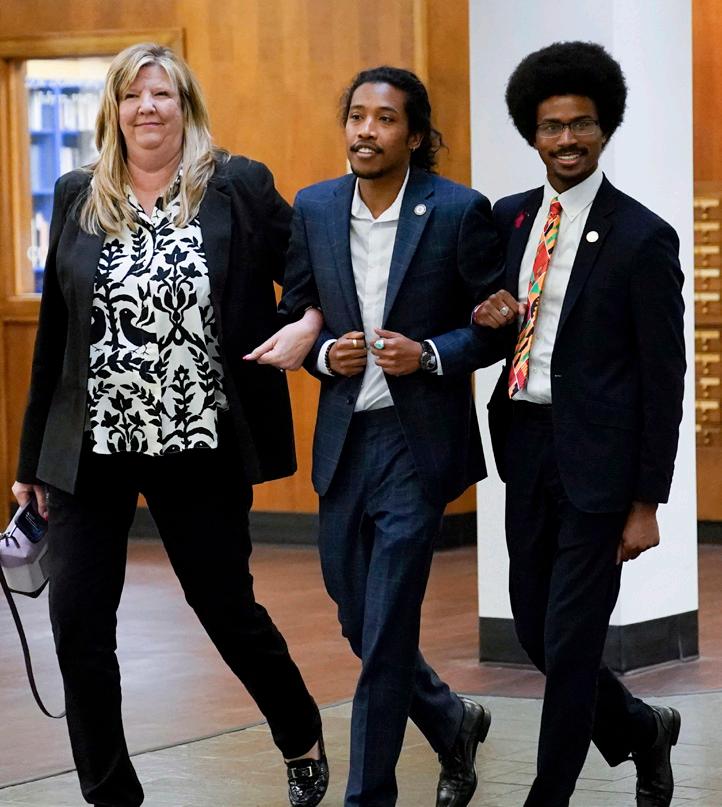
This follows the mass school shooting that took place in Nashville’s the Covent School on March 27, killing three students and three adults.
According to NPR, most expulsions are due to criminal conduct or abusive behavior, which makes the recent ones in Tennessee stand out, as they were expelled due for breaching the rules of decorum in the House.
Jones and Pearson used a bullhorn during the protest and were joined by Rep. Gloria Johnson. Jones, Pearson and Johnson were accused of being disruptive and bringing “disorder and dishonor” to Tennessee’s House of Representative, according to The New York Times.
On Thursday, April 6, protesters poured into the House to protest not only gun control, but also the expulsion of the two young Representatives.
There is debate that the expulsions had to do with the race of the Representatives, since Johnson, who is white, escaped expulsion while her Black colleagues were expelled only months into their two-year terms.
“I am a 60-year-old white woman, and they are two young Black men,” Johnson told CNN.
According to Johnson, Jones and Pearson were questioned by lawmakers in a demeaning manner before the expulsion.
“I think what happened was a travesty of democracy because they expelled the two youngest Black lawmakers — which is no coincidence — from the Tennessee state legislature because we are outspoken, because we fight for our district,” Jones said on “CNN this morning.”
According to The Washington Post, when a seat in the House of Representatives is opened, local officials choose a replacement, who can be the same lawmakers that were expelled.
The Nashville City Council is hosting a meeting on Monday to send Jones back to the Tennessee House.
Opinions
COLUMN: Brandon Johnson's victory reaffirms the viability of progressive candidates
By Jake Cox Opinions EditorIn a victory for organized labor, Brandon Johnson was elected the next mayor of Chicago on April 4. Johnson was elected on progressive ideals and the full might of the Chicago Teachers Union (CTU). This continues a trend of progressives winning seats held by lifetime moderate candidates, seen across the nation. Real progressives are viable candidates. All that is required is the backing of real people and real organizers — not big money.
This shift in the political landscape began back in 2018, with the election of Alexandria Ocasio-Cortez to NY-14. Ocasio-Cortez, a candidate running on Medicare for All and other progressive reform was able to unseat a career Democrat solely with a grassroots movement — no super PACs required. She has served as the face of the progressive movement across the country, an example of a working class politician who has stuck to her values— uncorrupted by the political machine.

This trend has continued across the country. Grassroots organizing is nothing new, but in the last few years, it has spread like wildfire. Activists like former Georgia state Rep. Stacy Abrams mobilized hundreds of thousands of voters
— turning her state context in which Johnson emerged, as a former Chicago teacher and paid organizer for CTU. Johnson is the “every man” -
gressive voters, especially young voters, were looking for.
After leaving the classroom in the early 2010s, Johnson took a stint as an organizer for CTU— leading the 2012 strike of more than 25,000 educators. After his time as an organizer, Johnson became a Cook County commissioner with endorsements from CTU/ AFT Local 1 and Service Employees International Union. These endorsements followed him to his mayoral run.
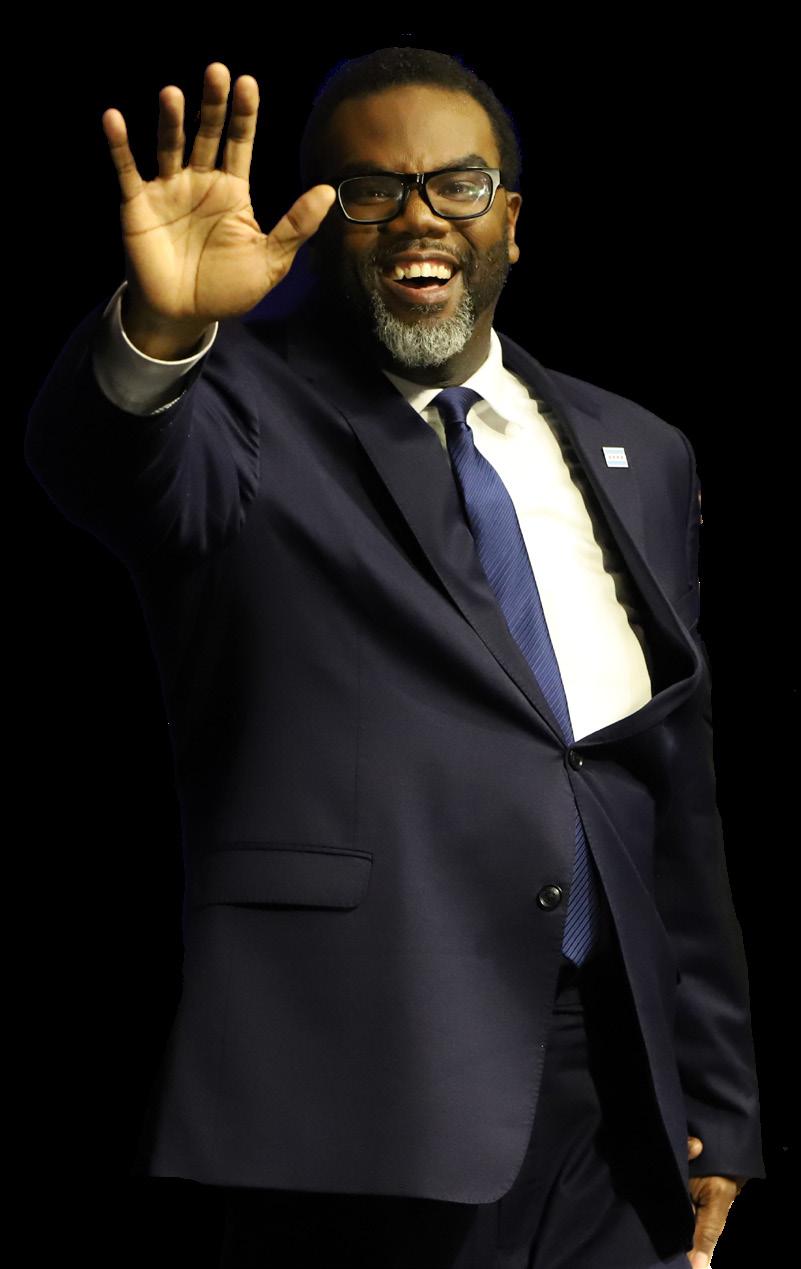

Diametrically opposed to the public school teacher and CTU organizer stood Paul Vallas, the former CEO of Chicago Public Schools. The millionaire resides in Palos Heights, which many Chicagoans would hardly consider a part of the city. The suburb has a median income of $90,995, according to CMAP, far higher than the average Chicago household income.
Johnson resides in the Austin neighborhood on the West Side of Chicago. The median income in Austin is $35,555, according to CMAP.
Johnson’s reliance on people power can be seen in his endorsement by U.S. Sen.
Bernie Sanders at a rally before the election. Sanders has been the face of the progressive sect of American politics for decades, centering on people, labor organizations and the social safety net. Johnson's victory sends a powerful message. When candidates prioritize the needs of their constituents and reject the influence of big money, change is possible.
Johnson campaigned on the improvement of mental health support and community-based intervention rather than vowing to beef up an already bloated Chicago Police Department. More cops is an ineffective cop-out to solve crime in Chicago. It is a fear-mongering ode to the rich who do not live in this city but love to malign it as a dangerous “hell-hole.” Problems with structural roots require structural solutions. More cops cannot solve the problems in Chicago.
I almost feel like an imposter. I am not from Chicago. I just go to school here. However, after living in the city for a short six months, it seems clear that a moderate masquerading as a Democrat was not right for the city, and from the results on Tuesday
voters in Chicago agree.
It is ridiculous to ignore the impact college students and other young adults, many of whom are new to the city, can have on elections. In the run-off, youth voter turnout (18-24) was up 32% compared to the general election. We showed up, and it turned out older voters did not. The 65-74 age group decreased by 5% from the general election, according to the Chicago Board of Elections.
It feels naïve to position Johnson as a champion for Chicago already, he has yet to take office. But a person’s past and the people they surround themselves with tend to do a good job at defining their character. Surrounding himself with teachers, union activists and organizers gives me a good feeling about what he will bring to the city.
It is hard to not have a fleeting glimmer of hope when a real progressive candidate wins the mayoral seat in the third-largest city in the nation. Chicago is on a gambit, with the awesome power to show the rest of the nation what progressive leadership can do to improve a city.
Scan

Not your average
Branko’s mom and pop shop
 By A mber Stoutenborough Multimedia Managing Editor
By A mber Stoutenborough Multimedia Managing Editor
tening ear to customers, only employee and the grandson to Branko Joradovski are just a few names Nenad ‘Joe’ Jovanovic holds at his family owned sandwich shop and Lincoln Park staple since 1976 called Branko’s.


cated on 1118 W Fullerton Ave, you might mistake it for the set of the Blues Brothers. The ‘70s style wood paneled walls surrounding the restaurant are engulfed in framed family photos, vintage Chicago and Led Zeppelin posters and over 50 printed restaurant reviews, some dating back to the 1980s raving about Branko’s service and homestyle meals.
If you squint, the colors of red and yellow are ubiquitous in the design, even down to the pop choices of Coca-Cola products displayed behind the counter. The only color jarring to this palate is the bright green plants swallowing the space by the front windows, which were previously potted by Andja Skurteska, the owner’s daughter who helped run the store before the pandemic.
From Monday to Friday, 36-year-old Jovanovic is behind the counter throwing fries into the fryer, prepping chicken in the back while also telling you a story about his grandfather owning two bread carts in Yugoslavia.

While his aunt, Gordana Jordanovska is the new owner of the shop and reopened the store after the pandemic as a promise to her mother, Jovanovic works everyday to continue the family legacy and charm. Making the same recipes as his grandparents made when they first came to the United States in 1976 as immigrants from former Yugoslavia.
“Sentimentality is important to Gordana,” Jovanovic said. “This was like a big thing for her, she made a promise to my grandmother and she kept it, and I’m glad I get to be here to continue the dream.”
The restaurant’s menu consists of the same customer favorites previous to the pandemic: pizza puffs, hot italian beef on fresh french loaves, balkan vegetable Pasulj, and classic cheeseburgers. Even the bread company has not changed for this family business. D’amato’s and Vienna Beef are still staples at this restaurant as well as the secret family recipes.
Jovanovic was not always sporting the bright red Vienna Beef apron at the neighborhood establishment. Previous to taking over day-to-day business at Branko’s in June 2022, Jovanovic worked on film sets and Chicago fine dining.
“I did film work in Florida and Chicago then came back to work for a few restaurants, one that I knew for over a decade,” Jovanovic said. “It treated me like a family
 AMBER STOUTENBOROUGH | THE DEPAULIA
Family friend Ilija Petrevski waters the many plants that line the Branko’s storefront. Plants are among many of the personalized pieces of Branko’s history that line the walls.
AMBER STOUTENBOROUGH | THE DEPAULIA
Nenad “Joe” Jovanovic smiles at family photos. Jovanovic is grandson to namesake Branko Jovanoic.
Freshmen Jesse James Hoover (left) and Julie Jones enjoy their usual sandwiches on a Thursday afternoon. To them, Branko’s feels like ‘a different world.’
AMBER STOUTENBOROUGH | THE DEPAULIA
Family friend Ilija Petrevski waters the many plants that line the Branko’s storefront. Plants are among many of the personalized pieces of Branko’s history that line the walls.
AMBER STOUTENBOROUGH | THE DEPAULIA
Nenad “Joe” Jovanovic smiles at family photos. Jovanovic is grandson to namesake Branko Jovanoic.
Freshmen Jesse James Hoover (left) and Julie Jones enjoy their usual sandwiches on a Thursday afternoon. To them, Branko’s feels like ‘a different world.’
average Joe:
re-opens, welcomes new faces
“Everything I ended up doing in my life, I ended up using for this and like a beautiful way, so if I can provide that for somebody that would be awesome.”
Jovanovic points to a framed photo of his grandfather standing proud next to his own bread cart back in Macedonia. Across the room is another photo of both his grandparents beaming in front of Branko’s 47 years ago opening the store. Jovanovic humbles himself to explain that his success all comes from his family.

“My grandfather renovated [Branko’s] himself, tore down the walls and designed it in 1976, and you can really see how happy my grandparents were to just be a part of this community,” Jovanovic said. “This whole journey was really important for them and making food that everyone enjoys has always been the main goal for them.”
The smells of home cooking waft through the air. The distinct aroma of Vienna Beef and giardiniera hot peppers bring nostalgia to even the youngest customers. The steady flow of service slows down and two DePaul freshmen, Juliet Jones and Jesse James Hoover, walk in and greet Jovanovic by name. The students jokingly jabbed at Jovanovic for missing their most recent performance at DePaul’s theater school and he profusely apologized and blamed working late as his excuse.
After they order “the usual,” Jones and Hoover sit down facing the counter and yell across the room to Joe for not playing his music.
“When we first came in, it was funny because he was trying to switch songs and blame Spotify for the music tastes, but we know better now,” Hoover said.
Jones and Hoover first found the sandwich shop after randomly walking by one day after class. Neither of them would imagine they would soon become some of the many regulars Jovanovic greets everyday.
“We were walking by and I said to him, hey, you know that sandwich shop opened again. The one Joe Keery frequented at,” Jones said. “And now we are best friends with Branko’s Joe.”



From its friendly staff (singular) to its classic Mom and Pop style shop,
Jones and Hoover find Branko’s to be more than just a place to grab food between classes.
“We keep coming back you know, like when you sit here, it feels like that’s not the real world, this is,” Hoover said. “This definitely feels like a place from a different world.”
While the proximity, food prices and ambience bring back loyal customers, to the young Blue Demons, Branko’s would not be the spot without Jovanovic.
“I’ve got a lot of food allergies, so I have to be very stingy and picky about the places that I eat,” Jones said.

“I told Joe on my first day because I wasn’t sure, and he immediately started spitballing, trying to find if there’s anything he can make for me, and we figured it out so now I always have something here.”
While nestled closely to DePaul’s campus, Branko’s is a home to many beyond the four-year college degree. For Jovanovic, many customers have been coming since he was young and they do not let him forget it either.


Illija Petrevski, a friend of the original owner Branko, comes in occasionally to water the plants and request extra crispy fries. His presence to Jovanovic is one of the many friendly faces who remember him as a child.
“This whole community is my family,” Jovanovic said. “I like Branko’s to be a safe haven for students and locals alike. I love meeting new people and making them food and seeing old faces. I hope I can continue to bring joy to Lincoln Park for a long time.”
Old DePaulia articles, food reviews dating back to the store’s opening in 1976, Branko’s merchandise and images of family and friends tell a story of this Lincoln Park focal point. Javanovic prepares food in the back of the store, one of the many tasks he completes on a day-to-day basis as the the primary employee of Branko’s. AMBER STOUTENBOROUGH | THE DEPAULIA AMBER STOUTENBOROUGH | THE DEPAULIA AMBER STOUTENBOROUGH| THE DEPAULIALa DePaulia
El voto latino muestra la diversidad de perspectivas entre generaciones
By Jacqueline cardenas Jefa de Redacción, La DePauliaRepartiendo volantes en el lado suroeste de Chicago fue como Gloria Drew, de 70 años, participó en las elecciones a la alcaldía de este año.
Una de las razones por las que se animó a votar e informar a otros electores fue porque los jóvenes latinos como su hijo, Billy Drew, le dieron esperanza en el proceso político.
“Los jóvenes saben lo que está pasando en sus comunidades”, dijo. “Me motivaron porque son el futuro”.
Billy, un organizador de la Organización Política Independiente del Distrito 12 quien fue voluntario para la campaña del ahora alcade electo Brandon Johnson, dijo que los jóvenes latinos frecuentemente asumen la responsabilidad de informar a las personas mayores de su comunidad mientras también se encargan de derribar los sentimientos anti-negros arraigados en la población latina.

Una de las razones por las que la mayoría de los latinos votaron por Paul Vallas fue por el enfoque de “mano dura contra el crimen” que se basa en el miedo contra los miembros de la comunidad negra, sugirió Billy.
“Vallas estaba usando eufemismos para decir ‘si quitamos los fondos a la policía, entonces no estarás a salvo del ‘otro’”, dijo Billy.
Entre los votantes latinos registrados, 46% favoreció a Vallas, y 35% prefería a Johnson, según una encuesta publicada el martes por el Centro para el Estudio de la Diversidad y la Democracia de la Universidad Northwestern y una coalición de organizaciones sin fines de lucro negras y latinas.
Jocelyn Bravo, una trabajadora de la Coalición de Illinois por los Derechos de los Inmigrantes y quién votó por Johnson, dijo que tenía que abordar la
desinformación entre la comunidad latina.
“Hubo algunos latinos que pensaron que Paul Vallas era latino”, dijo Bravo.
Promover que voten de acuerdo a sus propuestas en lugar de hacerlo según la raza u otras identidades de un candidato debería ser el centro de las conversaciones con los electores latinos que están indecisos, dijo Bravo.
“A veces cometen el error de seleccionar a un latino que es dañino para nuestra comunidad”, dijo Bravo.
Otras razones por las que algunos latinos no acuden a las urnas el día de las elecciones es porque no confían en los políticos, no saben que hubo elecciones o perdieron la motivación luego de que el congresista Jesús “Chuy” García quedó cuarto en la primera vuelta, dijo Bravo.
Aunque votar según la raza no es nuevo en las elecciones de Chicago, Johnson se convirtió en el alcalde número 57 de la ciudad al recibir el apoyo de
muchos residentes de los lados norte, oeste y el núcleo del lado sur.
Vallas obtuvo votos del extremo noroeste, las partes más occidentales del lado suroeste y el lado sureste, el Loop y el lado norte cercano.
A lo largo de las elecciones, los votantes mayores constituyen la mayoría de los votos, aunque los datos electorales no oficiales muestran que los habitantes de 18 a 24 años vieron un salto del 30% en la participación este pasado martes en comparación con febrero. Aún no hay datos que demuestren la participación entre los grupos latinos de diferentes edades.
Pero no todos los latinos votan igual. Lenin Plaza, quien alguna vez fue un votante de García, dijo que votó por Vallas en la segunda vuelta debido a su enfoque en el crimen y la economía.
Vallas se comprometió a lo largo de su campaña a traer de regreso a los policías retirados para llenar las vacantes
Chef aspira a llevar sus sueños y recetas
Vanessa Vianey Abeja, no siempre había vendido la comida mexicana que preparaba en su casa, y mucho menos interactuaba con clientes con facilidad.
Pero con el apoyo de su abuela materna, Elisa, la joven empezó a vender uchepos y corundas frente a su casa, en La Villita.
Al principio Vianey se sentía tímida y tenía miedo de vender frente de su casa pero su abuela la ayudó a enfrentar ese temor.
Vianey recuerda el momento en que su abuela la miró a los ojos y le dijo:
“¿Miedo de que? No más hazlo.”
La franqueza de su abuela le dio a Vianey la confianza que le faltaba. Continuó vendiendo en el mismo lugar, entre las calles 28 y Drake, hasta que el verano terminó.
“A veces otros ven en ti cosas que aún no puedes ver en ti misma”, Vianey dijo.
En aquel tiempo, Vianey solo vendía uchepos y corundas, dos comidas originarias de Michoacán, México, el estado natal de su abuela Elisa.
Los uchepos son variantes de los tamales tradicionales, pero se preparan con granos de maíz frescos y otras especias, los cuales dan un sabor dulce.
Las corundas se envuelven en hojas del tallo de maíz fresco.
Vianey aprendió a preparar las comidas “ricas y simples” de su abuela durante la pandemia en 2020.
Por muchos años, Elisa fue una ama de casa que cocinaba todos los días y se dedicó a cuidar a su familia y a sus nietos. Vianey recuerda como observaba y ayudaba a su abuela en la cocina; son memorias que siempre guarda en el corazón.
Los últimos años de Elisa estuvieron llenos de amor y el cuidado de su familia. Pero Vianey dijo que a su abuela no le gustaba que tuvieran que cuidarla porque se sentía como una carga para la familia.
Su abuela Elisa falleció a los 92 años este año.
“Yo creo [que] ella ya estaba lista para partir”, dijo Vianey.
Elisa nació en Nocupetaro, Michoacán, conocido como “uno de los municipios más pobres” del estado de Michoacán. Cuando conoció a su esposo, Abram Abeja, decidió junto con él mudarse a Chicago.
Vianey escribió en su columna, en Familia Kitchen, que su difunto abuelo Abram le contó que las razones por las cuales se mudaron a los Estados Unidos fueron la fe y la comida.
en todo el Departamento de la Policía de Chicago y también prometió desplegar agentes en los mismos vecindarios para frenar el crimen.
El enfoque de Johnson sobre el crimen se centró en su plan “Tratamiento, no Trauma”, que priorizaría las respuestas no policiales a las emergencias de salud mental y las disputas domésticas.
Plaza dijo que sentía que los comentarios anteriores de Johnson sobre “desfinanciar a la policía” fueron comentarios “irresponsables”.
Incluso si Johnson tuviera un enfoque de mano dura contra el crimen, Plaza dijo que aún no votaría por él porque sentía que con frecuencia frenaba las preguntas de los moderadores en los foros abiertos a los que asistía.
En una encuesta realizada por la Federación Hispana, más del 70% de los votantes negros y latinos piensan que Chicago estaría mejor si las comunidades negras y latinas trabajaran juntas en los problemas.
Karina Ayala-Bermejo, la directora ejecutiva y presidente del Instituto del Progreso Latino dijo, “desmiente la vieja narrativa de que los votantes de estas comunidades solo votan según criterios raciales”.
Ayala-Bermejo, madre de dos adolescentes, dijo que se convirtió en una tradición familiar acudir a las urnas todos los días de elecciones.
“Cuanto antes se involucre a un joven en el gobierno local, estatal y nacional, más conectado se sentirá con los problemas y los resultados”, dijo. “Si hay algo que esta elección le enseñó a nuestros jóvenes, fue el poder de cada voto”.
de su abuela a lo alto
“Porque nunca quisieron ver a su familia morir de hambre así”, dijo Vianey. “Cuando no creces con mucha comida, lo es todo. Mientras tuvieran comida en la mesa, la familia estaba bien”.
Años después, Vianey se graduó de una escuela culinaria. Ella asistió en la escuela Food He.ro, la primera escuela culinaria dirigida por latines para latines.

“Desde que conocí a Vianey, ha mostrado una inmensa pasión por la cocina, particularmente compartiendo recetas culturales y rindiendo homenaje a su abuela”, dijo Mila Johnson Pérez, mentora de Vianey. “Ella tiene un verdadero deseo de traer alegría a los demás a través de su cocina”.
Vianey también sigue desarrollando sus habilidades para conectar y comunicar con la gente. Ya ha tomado grandes pasos en rumbo a esta meta al abrir su cuenta de Instagram dedicada a compartir sus recetas.
Recientemente inició un segmento llamado “Vivi’s Table”, donde cocina en vivo y se une con líderes de la comunidad para discutir varios temas.
“Ella realmente se dedica a ayudar a tantas personas como puede, con lo que puede. ¡Soy su fan número uno!,” dijo su novio, Ryan Alexander.
Vianey aspira a convertirse en chef
privada y llevar alegría a la gente a través de la cocina.
Su sueños en su carrera de chef son grandes, pero al final, ella simplemente quiere, “unir a la gente y pasar un buen rato con buena comida, tal como recuerdo mi infancia”. Una infancia en la que, gracias a su abuela Elisa, aprendió sobre la magia que puede ocurrir en una cocina.
Arts & Life
Chicago’s newest sketch comedy show is a landscape for storytelling
By Meredith Bach Contributing WriterIt is a show far from normal and better than okay. “Everything You’re About to See is Normal and Okay” is a musical sketch show devised entirely by DePaul students, and it is taking the Annoyance Theater on Belmont by storm. In the course of an hour, audiences are captivated in a comedic telling of relationships, sex, pop culture and absurdity.
Through a young, creative and queer perspective, the performers offer a fresh comedic landscape for storytelling and music — using their current and creative ideas to perform songs that are both informative and entertaining. “Everything You’re About to See is Normal and Okay” consists of 1520 original songs that explore comedy in a number of clever contexts. Throughout the production, the audience will find themselves experiencing awkward clashes between roommates, controversial kinks between partners and a road trip through an apocalyptic world. It is at once pleasantly relatable and entirely absurd.
The brains behind this collection of work are those of DePaul’s own comedy arts program. Students can get their Bachelor of Fine Arts degree in Comedy Arts through DePaul’s theater school. For months, the students worked with directors and musicians to generate a show that is both boisterous and becoming.
The cast is comprised of seven students: Ally Montgomery, Isha Pati, Luke Herman, Justin Jacobs, Kathryn Courtney, Sydney Copeland and Rocky Wenrich. The group was selected in a competitive audition process held in early September, where the majority of the comedy arts program auditioned with their own packages of original songs, musical talent and unique performances.
“We wrote this for you. This is complete-
ly for college students,” sophomore Luke Herman said. “College audiences will really appreciate seeing themselves on the stage in an experience that feels, like, really uniting.”

For more than four months, the curated cast worked with director Jeff Bouthiette, assistant director Tisby Critchley and musical director Brad Kempe. Under their professional guidance and boundless support, the group pitched and collaborated on ideas that were transformed into clever and catchy tunes. Their efforts cultivated a cunning composition of work that utilizes several instruments, talents and techniques. On top of acting and vocal performance, the ensemble skillfully incorporates acoustic and bass guitars, and even a melodica into their songs.
The group hosted previews in Novem-
ber to test the stockpile of material in front of a live audience. By that time, they accumulated almost 100 songs and sketches to work with. Bouthiette smiles when they remember this part of the process.
“To me, that’s what the most exciting thing about doing sketch comedy is,” Bouthiette said. “It’s like living in real time and figuring out what is the best choice for everything.”
Consequently, the final production is one true to its trials and tests of public approval. At the end of the previews, the students and directors whittled down the list to the 15-20 pieces that are now being presented at the Annoyance Theater.
“It’s well-polished,” stage manager Melina Arevalo said. “It’s been worked on for
so long compared to shows that are usually created quickly and then done with ... we are always moving.”
In January, they performed in DePaul’s “Messfest,” a student-created sketch, standup, improv and music show that spans over the course of an entire weekend. After all the passion put into the project, the show was a meticulously sculpted masterpiece and a smashing success. For that reason, “Everything You’re About to See is Normal and Okay” was officially picked up by the Annoyance theater for an additional 10 weeks.
Annoyance Theater is popular theater located in Lakeview that showcases plays, improv and comedy sketches.

The cast and crew held their opening night at the end of March and are hopeful and expectant of an exciting spring season ahead of them. Their fixed feature at the Annoyance now poses as a different performance than the others that are typically put on. The theater often showcases talents ranging from their mid-20s to early 30s, making the cast of “Everything You’re About to See is Normal and Okay” an astoundingly young group. However, because of this, the show offers a fresher perspective that is unique to the theater’s common comedic scene.
“It’s a great glimpse into rising comedians and what the comedy scape is going to be looking like soon,” Arevalo said. “It has a youthful yet mature POV, and there’s a lot of creativity within it.”
The cast and crew are excited to bring their talents and hard work to the mainstage every week.
“It’s funny, and it has music in it,” Bouthiette said. “So you should come and laugh with us!”
The show is at the Annoyance Theater every Thursday at 7 p.m. until May 17. “Everything You’re About to See is Normal and Okay” tickets are less than $10 and additionally discounted for DePaul students who
Ally Montgomery (left) and Kathryn Courtney perform in “Everything You’re About to See is Normal and Okay," running every Thursday at the Annoyance Theatre in Lakeview. MEREDITH BACH | THE DEPAULIA MEREDITH BACH | THE DEPAULIA Luke Herman is one of seven DePaul students from the comedy arts program in the show.Academic burnout brings into question student mental health, coping skills
By claire tweedie Staff WriterAs spring quarter comes to full bloom and students make their final push toward summer break, academic burnout threatens mental health and productivity, leading to symptoms like exhaustion, lack of motivation, and increased stress. When better weather and brighter days are not enough to ease these academic challenges, students look to healthy coping skills and solutions to prevent burning out before they can even tan in the sun.
Grace Lemmon, an associate professor in the Department of Management and entrepreneurship, defines academic burnout as when the demands of your life exceed your resources.
Demands like time, emotion and attention help contribute to the likelihood of experiencing burnout. These can be manifested through indicators like workload balance, hours dedicated to classwork and social or emotional needs.

“As a student, you're meant to be experiencing more than the facts and figures in your textbook,” Lemmon said. “Burnout comes not just when you feel overwhelmed with demands but also because you anticipate all of these stressors coming your way.”
Freshman Astrid Myers said they are currently experiencing a small amount of burnout but felt it is easier to manage as they adjust to life at DePaul. Their burnout is caused by a lack of rest after consistently working hard with little to no breaks or outside support.
“Last quarter, I worked so hard to get my grades up and to do well and I did that,” Myers said. “One week for spring break was not enough though. Jumping right back into class really hit me in the face, and now it's hard to get energy from activities I usually enjoy.”
Lemmon believes students are at a higher risk of burnout due to their inexperience in dealing with the demands that lead to it.
Not yet having the skills to manage the effects of burnout means students feel it more intensely and have not figured out their own solutions to remedy it.
“It's a skill to be able to be aware that you're burnt out and regulate around that burn out,” Lemmon said. “You don't learn a lot in life about how to combat burnout. You hear people say to just take a rest or take some time off and you'll be fine but it's actually much more complicated than that. There are many additional steps you need to follow.”
Freshman Cailla Oakley-Lynch said she felt burnout while taking classes only related to her animation major. Many of these classes were project-based with conflicting deadlines which required more time spent at the Loop campus using software she does not have access to at home.
“If there's a pretty good balance between having a lot of studying, labs, papers and creative assignments it makes a difference,” Oakley-Lynch said. “Being an animation major pushes burnout in a certain direction though because for me I physically cannot think of another thing to draw and I’m forgetting how to use the software because of how much work is piled up.”
Lemmon said falling into a “grindset” can worsen burnout by encouraging people to deny necessary moments of rest along with social and emotional connections. She said people can ignore these in favor of working on a side hustle for financial gain rather than a healthy mindset.
“I have this constant need to always be
busy because if I’m not always doing something, then I’m not being productive,” Myers said. “With the mix of all these stressors in under one year, it's really hard to feel like I’m doing well in my academics. I’m just tired all the time and I can feel it at the end of every quarter.”

According to Lemmon, there are two steps to overcome burnout: awareness and regulation. Awareness is recognizing the signs that indicate you are experiencing burnout such as feeling easily annoyed, having less energy to do fun activities you would normally say yes to, and generally lacking energy. Regulation is finding ways to make those signs more manageable through self care.
During winter quarter, Myers spent 20 hours over two days finishing a final project. Regulation for them means avoiding that same overworking pattern and instead focusing on taking breaks.
“Also, if I feel like I don’t have time to do things like hang out with friends, I try to combine it with doing something else,” Myers said. “Going to dinner together is always a good time where I feel like not only am I eating dinner but I’m also surrounding myself with other people.”
After awareness and regulation, Lemmon said experimentation to find the best solution is necessary since burnout can be from different demands or stressors each time and require different methods to alleviate it. This includes finding individualized restorative activities rather than mindlessly scrolling, prioritizing responsibilities to re-
evaluate stress, and accepting the fact you cannot do everything.
“It's not possible to do it all,” Lemmon said. “You’re going to need to experiment with different things being a priority and not getting other stuff done. That is life and the earlier you can become comfortable with not being able to do it all, the better off you will be.”
Oakley-Lynch said she recognizes her burn out when experiencing low motivation, worsened procrastination and disorganization with her work.
“I really did not want to use my hand to draw, engineer or do anything that was even closely related to my major,” Oakley-Lynch said. “There’s a sort of misunderstanding between professors and students about workload, and it adds a lot of pressure that isn’t communicated early on.”
Although Lemmon does not believe burnout is completely preventable, she said the most important thing for students to understand is they can only do their best when it comes to recognizing and coping with burnout. She said acceptance of things makes burnout workable for students to manage and eventually solve.
“When you find yourself in a burnout state, know that you will not linger there long, you have tools and skills to hoist yourself out of that feeling, and you have the confidence to turn things around,” Lemmon said. “We can’t go through life avoiding discomfort and burnout is simply another discomfort.”
"When you find yourself in a burnout state, know that you will not linger there long."
Grace Lemmon DePaul Associate Professor in Department of Management and Entreprenuership
Two thumbs up
Remembering legendary Chicago film critic Roger Ebert
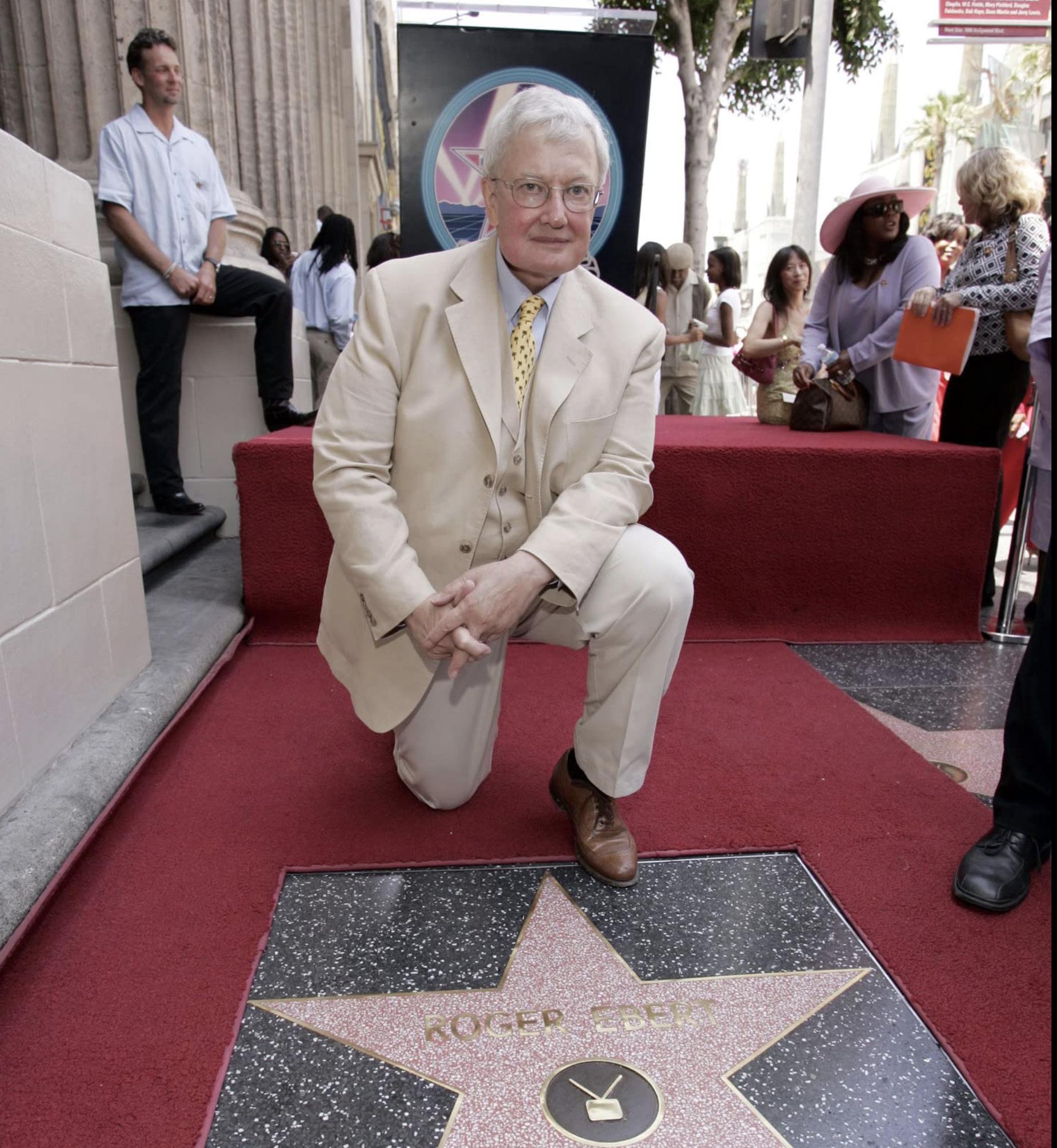 By lauren coates Staff Writer
By lauren coates Staff Writer
When it comes to film criticism, it is a profession that exists in relative anonymity.

Though a handful of names may come to mind for those that follow the industry, the concept of a universally revered, borderline celebrity-status has always seemed like a foreign one: that was, until Roger Ebert.
The bespectacled Urbana native is virtually synonymous with the modern notion of a film critic: with a body of work spanning half the length of film history and a slew of accolades – including the first-ever Pulitzer for film criticism –Roger Ebert wasn’t just a film critic, he was the film critic.
Last week marked the 10-year anniversary of Ebert’s passing, but while he may not be writing any longer, his legendary decades-spanning career at the Chicago Sun-Times will always remain a tentpole of the paper.
In addition to his reviews, Ebert’s countless books, 20+ years of television presenting and his personal blog on RogerEbert.com all stand as reminders of Ebert’s immense talent and passion for writing.

With roots in journalism as far back as circulating his own homemade paper “The Washington Street News” around his Urbana neighborhood in the 1950s, Ebert’s professional writing career began at the Chicago Sun-Times in 1967, where he scored the position of film critic after only five months at the paper and despite a lack of experience in the field. But it was his background as a self-proclaimed “newspaper man”, not simply an arts critic, that made his writing so extraordinary.
“He was just a movie lover who fell into this job,” said Steve James, the filmmaker behind “Life Itself,” a documentary about Ebert and based on the autobi -
ographical memoir of the same name. Even as his sophistication in the art of reviewing films grew considerably over the years, he never lost touch with that ability to write for viewers in a way they could easily relate to and understand. He was never trying to prove how smart he was—and he was brilliant.”
Ebert’s pragmatic yet insightful writing at the Sun-Times eventually landed him a long running television series, “At The Movies,” which began on regional midwest station, WBBM-TV, in 1986 before eventually finding nationwide success. “At the Movies” saw Ebert sparring with rival Chicago Tribune critic Gene Siskel over new releases each week. The first – and arguably, last – of its kind, “At the Movies” started out as a regional program that quickly reached nationwide success, catapulting Siskel and Ebert to genuine celebrity status.
“A lot of people encountered him first on TV,’” said Michael Phillips, Chicago Tribune film critic and former “At the Movies” co-host who served as successor to Gene Siskel in 2008. “It was about the least glamorous, show on television, but Roger transcended all that because he had something to say. He really was a good analyst about why something works. It’s that quote that people always haul out for Roger, ‘it’s not what a movie’s about, but how it’s about it.’”
Whether in print or on TV, what Phillips calls Ebert’s “carefully considered conversational” writing style did not just resonate with readers and fellow critics. Ebert also held close, longtime friendships with numerous filmmakers whose work he criticized, including the likes of Martin Scorcese and Ava Duvernay, whose interviews in “Life Itself” are full of nothing but fondness and reverence. But if someone else had done the film on Roger and was looking at films where Roger’s writing had a profound impact, they might very well have included “Hoop Dream,” James said, , one of the
filmmakers whose work Ebert frequently championed on “At the Movies.”
“You couldn't have had, you know, a bigger bullhorn for your film than Roger and Jean at that time, because they were the most powerful film critics in the world.”
An unexpected curveball brought Ebert’s television tenure to an early end when he stepped down from “At the Movies” in 2006 for treatment of his thyroid cancer, the result of which required the surgical removal of Ebert’s lower jaw, leaving him unable to speak.
Still, despite the lack of a physical voice, Ebert – who had been an early proponent of the internet – continued to find his audience by posting blogs and reviews to RogerEbert.com, which still operates today under the supervision of Ebert’s widow, Chaz.
In addition to RogerEbert.com, Ebert also serves as the founder and namesake of the University of Illinois Urbana-Champaign’s – his alma mater –EbertFest, a film festival kicking off on April 19.

“What I believe it is, is in part, he was giving back to the University, he wanted
to bring Hollywood, the world of film, to little Champaign, Illinois,” said Matt Fagerholm, RogerEbert.com’s literary editor. “But what I love about EbertFest is that everyone’s in this big, old, wonderful theatre – the Virginia Theatre – and there’s 1000 people in there, 1000 people in there but it's a wonderful communal space.

People are there, because Roger has opened their hearts so much, to being open to whatever movie you show.”
On the anniversary of Ebert’s passing, Chaz Ebert and the editors of RogerEbert. com published a collection of testaments honoring Ebert’s life and writing, all centering around his ever-present belief in the power of film to generate empathy.
“I believe empathy is the most essential quality of civilization,” Ebert wrote. “For me, the movies are like a machine that generates empathy. If it’s a great movie, it lets you understand a little bit more about what it’s like to be different. It helps us to identify with the people who are sharing this journey with us. And that, to me, is the most noble thing that good movies can do.”
'Macbeth': a reconciliationhaunting of fate
By lilly K eller Arts & Life EditorOne of Shakespeare's most well-known works, "Macbeth" tackles the question of how rapidly a man can descend into insanity. While the English playwright's answer may fall somewhere in the 200-page range, DePaul's Blue Demon Theatre adaptation maintains Macbeth's mania from his first appearance to his last.
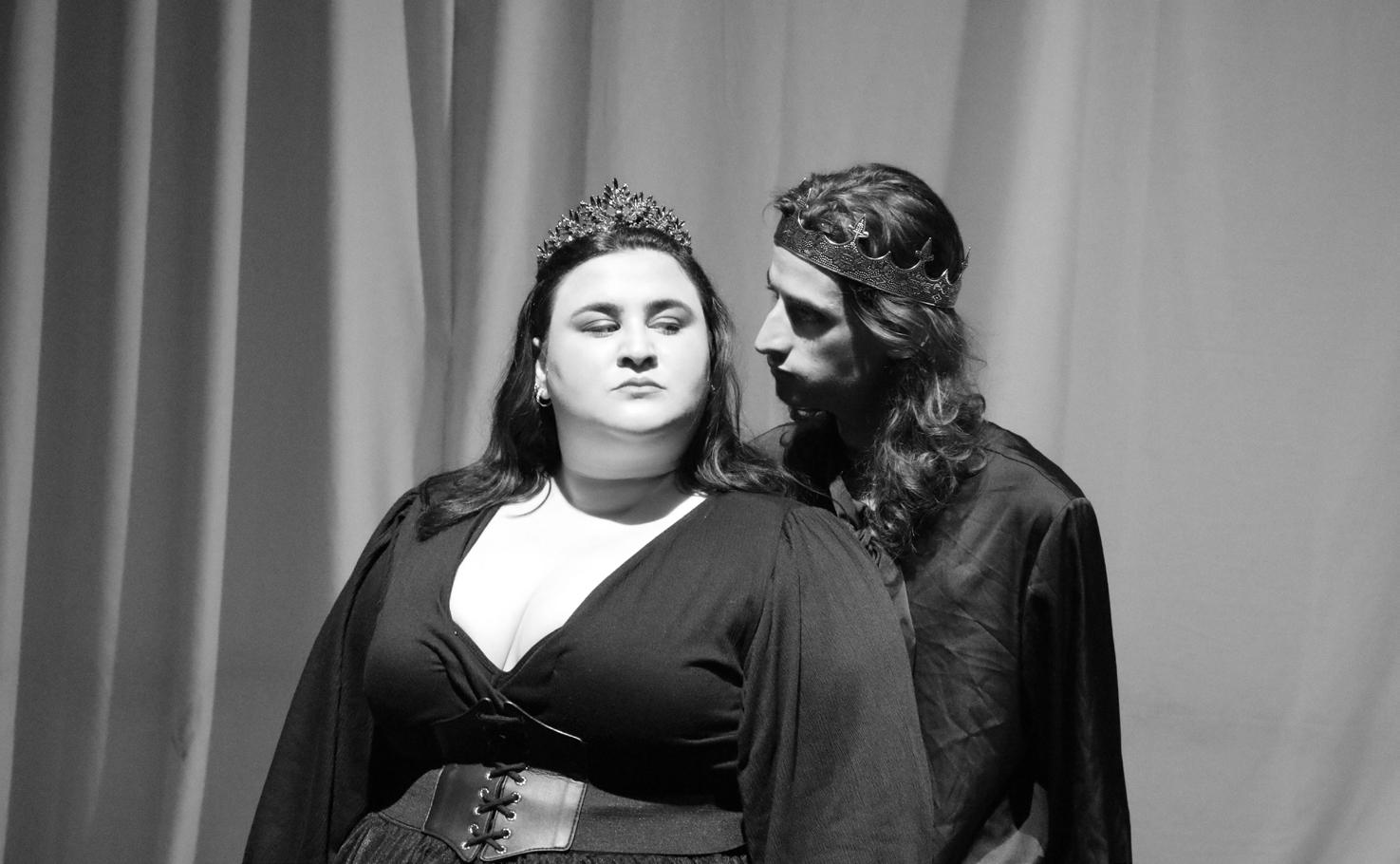
Held at Wit Theater and starring DePaul sophomore Elijah Valter as the play's titular character, "Macbeth" illustrates the rise and fall of a Scottish general after stumbling upon three witches in the forest. However, where Shakespeare's "Macbeth" haltingly embraces his hunger for power, Valter's portrayal emulates a man prepared to do anything for the throne moments after learning about his future.
Saturated with angst and melancholy, Valter does not shy away from Macbeth's self-obsessed nature and commands the audience's attention for each soliloquy to every moment in between. Mastering the glazedover vacantness of a man desperate for power, Valter's performance rarely stumbles, maintaining the play's haunting atmosphere from his first scene to his last. However, it was DePaul junior Anna Maria D'Ortenzio as Lady Macbeth whose performance defined the show.
Often leaving the audience with goosebumps, D'Ortenzio's stage presence held such palpability, I was certain I could touch it at times. Her embodiment of Lady Macbeth's mental degradation and repressed remorse for her role in her husband's crimes was chilling and, at times, downright uncomfortable to watch. Yet not even the play's climactic clash of swords could outshine D'Ortenzio's dramatic portrayal of Lady Macbeth's suicide, nearly bringing the audience to a standing ovation despite three scenes remaining.
Aside from the all-around stunning performance from all cast members, an additional highpoint of the play resided in director Grace Provan's unique expression of gender. From gender-bending traditional male characters like Lennox and Ross to embracing women's rights and wrongs, the Blue Demon Theatre's adaption never faltered when it came to justifying their version of "Macbeth."
Bolstering Provan's adaptation was her embrace of the play's supernatural elements. Although only appearing in a handful of scenes, the three witches' presence (Cayte Worthington, CJ McKenzie and Anna Sadruddin) transcended beyond their physical proximity, haunting the narrative like Banquo to Macbeth. All three performers were deeply committed to their roles, cultivating intense eye contact with the audience alongside their natural spooky elegance, leaving
viewers hungry for more every time they left the stage.
Additionally, the simple stage setup — containing only a handful of props in each scene — strengthened the play's overarching themes of tyranny, unchecked ambition and guilt. In scenes that featured King Duncan and later Macbeth, a lofty throne was secured to the center of the stage, swallowing whoever sat down. Furthermore, the monochrome costumes seemed to reflect each character's soul. In the first half of the play, Macbeth dawns a white shirt and black pants but is engulfed in shades of black by the final act, finalizing Macbeth's choice of power over peace. Lady Macbeth wears black for the entirety of the play. Macduff wears only white. Through these elementary details, the thematic narrative of "Macbeth" shines just as brightly as the tragic plot line.
However, the play's pacing sows seeds of unsteadiness throughout its two-hour runtime. One of Shakespeare's most approachable plays, with its quick tempo and rudimental focus on human nature, violence and regret, it is essential to not dwell in the space outside of Macbeth's mental decay. Yet too many scenes consisted of characters exchanging letters in passing, adding little to the famed plot and fracturing the relatively steady narrative.
Still, Blue Demon Theatre's production of "Macbeth" maintained the play's core principles and embraced the emotional complexities and old English with ease. Through Provan's unique adaptation, bunched with a talented cast and crew, the student organization created a satisfying yet unsettling experience, ultimately doing Shakespeare's vision justice.
The Theatre School Dean reflects on first year
By saMuel Mroz Staff WriterStepping out from her office of deanship on the fourth-floor of DePaul’s lauded theatre school, Martine Kei Green-Rogers quickly perks up to a chat on the origins of punk rock that four students are holding within earshot.
As a dean who loves to listen and even further lives to learn, it’s conversations like these that fuel her creative battery.
With an outfit of darkened flair — formal black attire lining Rogers from top to bottom — her position insists decorum, but her character boasts persona.
Amongst a sample of novels and the standard office amenities, these sparks seep through, as shelves lined with the memorabilia of Hello Kitty overlook a table circled by six vacant seats. It is here that students, staff and strangers alike all are given the same treatment. An open-eared Rogers, seated across from them, hangs onto every word that comes her way.
“After years at work, I have yet to wear myself out,” Rogers said. “I am still a bundle of energy.”
Rogers was raised in Norfolk, Virginia, where she was first enrolled in theater classes at age four by her grandmother. These sessions went on to supercharge her interests, with Rogers going on to earn a bachelor’s degree in theatre from Virginia Wesleyan University in 2002.
One professor’s reference to the word dramaturg — an expert in the study of plays, musicals or operas — and her life from then on was shaped around one ideal. She would go on to earn a master’s in theater history and criticism with a concentration in dramaturgy at The Catholic University of America in Washington. Finishing her education with a Ph.D. in theater and drama at the University of Wisconsin-Madison, her passion continued to evolve her perspective.
“Each play is a new experience and prospect,” Rogers said. “Every place I moved offered a new opportunity to learn.”
Her last stop as the interim dean of the Divisions of Liberal Arts at the University of North Carolina School of the Arts was all she needed to manage her takeover at DePaul. In all this change, she took a liking to variety over resemblance.
“One of the things that is the most interesting to me are people who don’t think like me,” Rogers said. “I am far more intrigued by people who don’t share the same ideology than people who do. In the end, I’m hoping my time here will inspire people to take note of these differences and grow from what they are, including myself.”
Director of Literary Development and Dramaturgy at the Oregon Shakespeare Festival Lue Douthit hired Rogers as her assis-
tant director at the festival in 2007, a position that involved elaborate research, conception and a broadened advancement of Douthit’s directorial vision.
“It was apparent from our first encounter that this was a special theater artist,” Douthit said. “While she has a resume with many different kinds of experiences, they always point in one direction. Every moment provides an opening for her to advocate for her students and create opportunities for them.”
DePaul’s student advising associate for The Theatre School Azar Kazemi met Rogers when working together at the festival in 2011 and now sees this advocation play out on a daily basis in the DePaul climate.
“Dean Martine’s professionalism, positivity, and expertise are invaluable in any production process,” Kazemi said. “Her commitment to equity and inclusion is seen through
her daily practice as an artist, educator, and now as an administrator.”
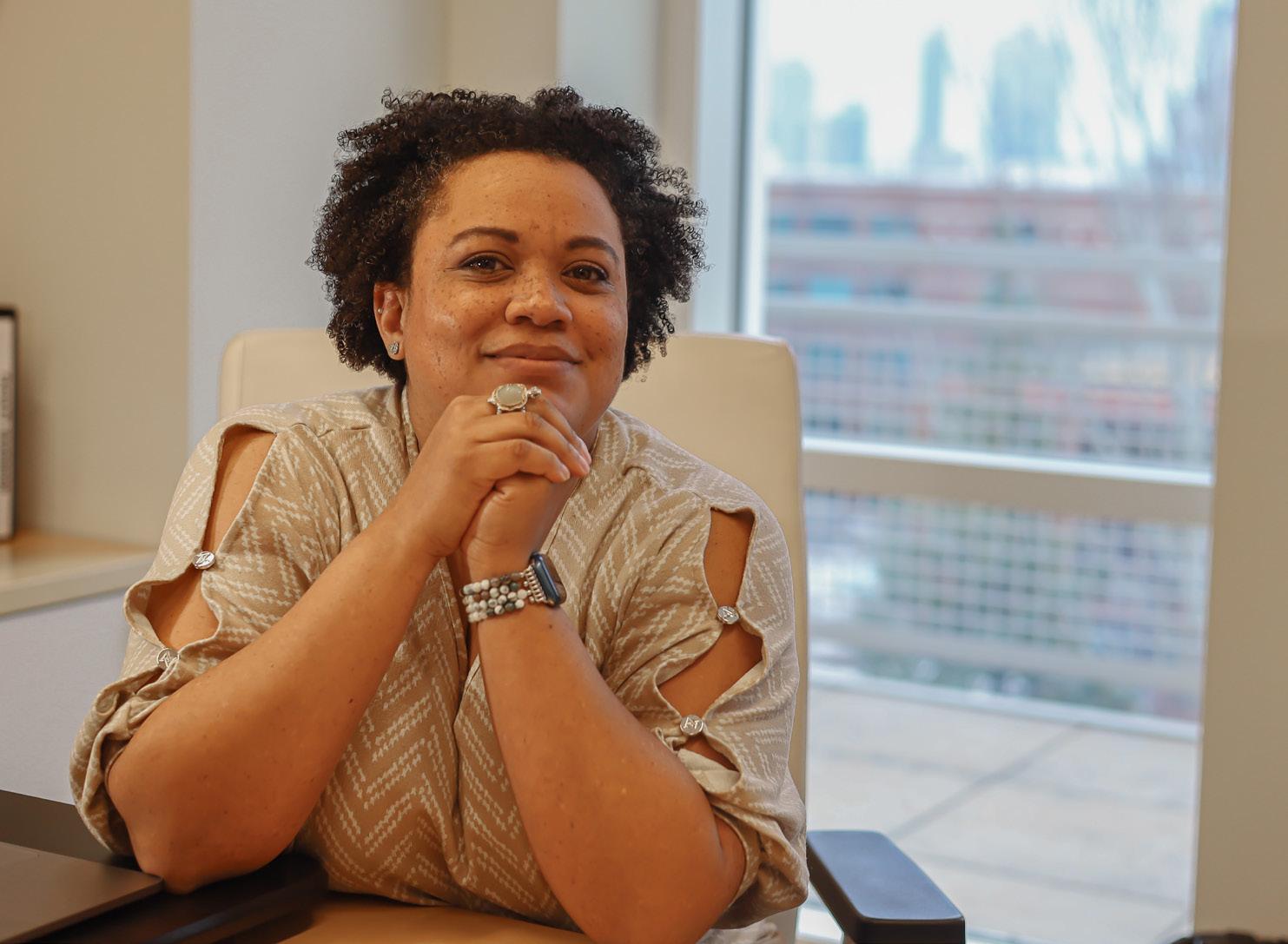
Now looking towards the future of the program and her growth alongside it, Rogers made it clear how these values define her role.
“Part of what I’ve had to do is say what is the history of this place, where are we now, and where do we want to go,” Rogers said. “A dean’s job is about vision. The moment I don’t have that anymore it’s time to go and do something else.”
Jeremy Cohen, artistic director of the Playwright Center — a non-profit theater company based out of Minneapolis — noted a DePaul victory in appointing such a rare talent.
“She is one of the most sought out theater artists,” Cohen said. “She somehow manages to do the impossible in harmonizing brilliance as a dramaturg, educator, mentor, a values-centered administrative leader and as someone who always sees the whole person first.”
Involved in over 40 theater productions within her career — spanning the West to East Coast and all space between — Rogers continues to build atop this balancing act. Dramaturging for local theater companies while her book on contemporary Black performance — a personal project she has carried out with an educator at Loyola University and a former professor at Columbia College Chicago — sleep comes short.
In the end, it is her position in education and desire to keep expanding her knowledge that makes these restless days’ worth it.
“I want people to come as they are and who they are and let’s talk about how we make art together,” Rogers said. “My influence is about continuing to ask the questions about the world around us through the art we make and pushing ourselves to actually ask those questions than just assume the answers.”
Fantasy film appeals to players and peasants alike 'D&D: Honor among thieves'
By claire tweedie Staff Writer


Once upon a time, liking Dungeons & Dragons may have been the reason someone stole your lunch money. Now, “Dungeons & Dragons: Honor Amongst Thieves” has friends and foes alike voluntarily throwing money at a movie ticket to see the latest fantasy comedy blockbuster — and for good reason.
The film released on March 31 and quickly rolled a natural 20 in charisma on audiences, as the movie currently boasts a 94% audience score on Rotten Tomatoes.
The general plot follows our ragtag band misfits on their quest to re-steal a magical relic and defeat the villainous Red Wizard holding it. Along the way, themes of morality, family and grief cast a spell as you fall in love, not just with Regé-Jean Page’s slow-motion fight scenes, but also with the inherent heart the movie holds.
The tabletop role-playing game published in 1974, once synonymous with geeks, saw a change of heart in recent years as hipsters and “Stranger Things” super-fans picked up 20-sided dice to try their hand at the notorious game.
With such a drastic shift in perspective on this facet of gaming culture, Hollywood was bound to capitalize on the franchise sooner rather than later. Yet, they somehow did it right and crafted a movie for everyone to enjoy, no matter their character level.
While the lighthearted humor landed
perfectly, with just enough silliness and game references to draw viewers in for more, the funniest part was simply Hugh Grant’s presence.
In truth, it is hard to be entirely immersed in a movie about Dungeons & Dragons when every few scenes the BAFTA-nominated actor with a decades long career pops up, boasting random dialogue about the state of his kingdom and the questionable adviser at his side.
This tongue-in-cheek attitude though is exactly what makes it such an enjoyable film. There is no grave seriousness to hinder the movie but rather a complete
acknowledgement of the source material’s ridiculousness and a genuine love for what they have done with it.
The chemistry between Chris Pine and Michelle Rodriguez helps propel the movie past simple fantasy tropes and into those of a buddy-cop movie.

While the writers could have easily inserted an unnecessary romance subplot for the duo, they thankfully refrained. Instead, the pair and their makeshift family create a more meaningful dynamic that ups the stakes of their quest and of the audiences’ interest.
Plus, their perfecting of the brain and
brawn trope is hilarious to watch in action.
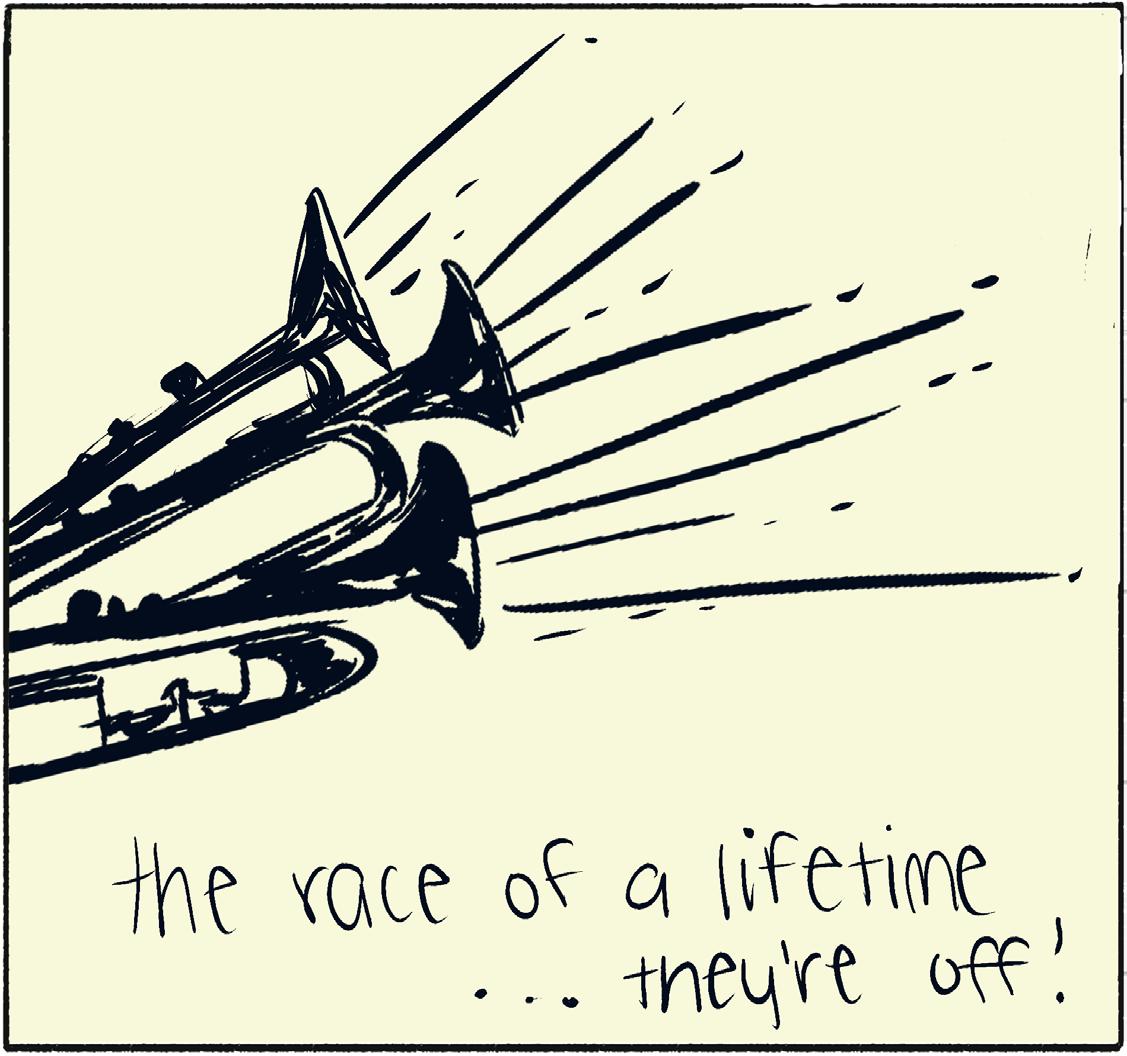
The less than subtle message about losing family and subsequently finding a new one helps add depth to an otherwise goofy movie.
Pine’s character arc takes us through his battle with grief over losing his wife and daughter alongside his physical battles against wizards and castle guards. The ending is overly predictable, but the moments of vulnerability from our adventurers help humanize the fantasy and make for a satisfying watch.
Although an entirely wonderful popcorn-flick, the movie fell short in terms of predictable storylines and occasional cringy dialogue.
However, the short-comings hardly outweigh the enjoyment and it is easy to gloss over a few lines the writers should have reconsidered.
Especially when you are already accepting the fight scenes against obese dragons and Justice Smith’s awful magic skills. You know, all of the other totally realistic and logical parts of the movie.
The movie takes the disbelief of viewers and runs with it, taking you to new levels of absurdity to create an enjoyable experience for any player or movie-goer.
“Dungeons & Dragons: Honor Among Thieves” knows exactly what it is without trying to rewrite its cultural stigma. It is hard to make the game this palatable on-screen for a large scale audience, yet it succeeds through innocent laughs and heartfelt connections.
Funnies off Jackson
What’s Fresh
The new face of folk-horror: 'Enys Men'
 By ethan M attheus Staff Writer
By ethan M attheus Staff Writer

There is something primitive about Mark Jenkin’s new film “Enys Men.” It was shot on 16mm film and developed by hand. There is almost no dialogue. The sounds are explosive and unadulterated. It has been described as a “folk-horror” film which is fitting when you consider the word folk implies the unearthing of lost origins. In this sense it is archaic but also new. “Enys Men'' is stripped down to the barest aesthetics and to great effect. Mark Jenkin has crafted a film that to some will be deeply infuriating, but to others will be a liminal and unnerving experience.
I recommend this film cautiously. As is indicated by its 31% audience score on Rotten Tomatoes, it is not kind to the viewer by any means. The plot, in as much as there is one, follows a lady credited as The Volunteer, played with frenetic energy by Mary Woodvine, as she observes a mysterious flower on an uninhabited island off the English coast. Slowly, reality begins to fade as characters from the island’s past begin to appear before her. Are they apparitions? Is she going insane? Is she reliving her own trauma? If you expect satisfying answers to any of these questions then “Enys Men” is not the film for you. It has other preoccupations.
Jenkin has been open about how he wanted to make a uniquely Cornish picture, one which was not indebted to Hollywood’s sensibilities. His previous film, “Bait,” dealt with the erosion of the British working class
in a cavernous space beneath her cottage and hears a priest’s phantom praying in the night. A stone memorial that has been built to commemorate sailors who died off the island’s rocky shores seems to move when unwatched. The film is deeply abstract so it never firmly presents a thesis, but all these elements coalesce to show a culture that is disappearing.
with grimy interiors. At night, the cavernous spaces explored by The Volunteer are so dark that it is unclear whether the walls are drenched in water or blood. Noises clash into distorted soundscapes that occasionally overwhelm the senses. It is amazing that Neon picked something this avant-garde up for distribution, and hopefully “Enys Men” makes its money back at the box office so
academic rigor while others, like “Skinamarink,” are pretentious and bloated. Nonetheless, this filmic trend is a welcome reprieve from the typical blockbuster fare.
Whatever “Enys Men’s” box office is, Mark Jenkin has established himself as a talent worthy of serious consideration. Creating an original style that is tailored to a person’s cultural heritage is something many

St.Vincent’s
D e JAMZ
“Spinning freSh beatS Since 1581”

 By lilly K eller Arts & Life Editor
By lilly K eller Arts & Life Editor
Spring quarter may have only started, but do not fear, the finish line is in sight! Although there are still 10 weeks between us and summer – or being adults for all of my graduating folks – the air is getting warmer, and the sun is setting just a little later.
While life is far from perfect for many of us, I invite you to stand in the sun and embrace the little things in life, like opening your window and getting an extra hour of daylight while listening to this flowery springtime mix.
“Belinda Says” – Alvvays
A nostalgic blend of chords and upbeat lyrics, "Belinda Says," oozes comfort.
While I honestly couldn't tell you what this song is about, I've been obsessed with Alvvays’ unique indie sound since high school and am convinced they

cannot release a bad song.
"The Bug Collector" – Haley Heynderickx
While this isn't the happiest of songs, Heynderickx's imagery of nefarious bugs is one of my favorite things. Despite moving to Chicago to escape bugs, their springtime return is inevitable.


As an avid bug hater, I commend Heynderickx – and my mom – for always prioritizing the bug's life over their own fear and emotions because, by god, I do not. If I ever see a millipede staring with a vengeance, it's on sight.
"Hospital Beach" – Cottonwood Firing Squad
Emulating the warmth and humidity of the West Coast, "Hospital Beach" is the perfect song to listen to on your evening walk from the train or lazy day by the lakefront. Can you feel the stress melting away? No? Try harder. Anyways, I cannot wait until I am no longer bogged down by discussion posts or 100
Crossword

pages of textbook reading, but until then, I will listen to this song and pretend I have no responsibilities.
"South" – Hippo Campus

Recently over spring break, on the way back from a long country ski in Bozeman, Montana, this song came on shuffle and let me tell you, the vibes were unbeatable. A summery mix of escapism and finding life and opportunities elsewhere, I have always loved to listen to this song with the windows down, even if it's only 30 degrees out.
"Tek It" – Cafuné
Although released in 2019, this was truly my song of the spring last year. Did I find it through an Instagram edit? Yes. Anyways, last year's springtime nostalgia has forced me to add it to this year's spring playlist. Here is to another spring quarter of seeing the light at the end of the tunnel.

ACROSS
1) After-shave powder
5) Drop down?
9) Asian caregivers
14) Chocolate cookie
15) Super server
16) Commonplace
17) Liar of note
19) Pest-control brand
20) Blue
21) " ... and sat down beside It
22) Straightening up
24) Goods
26) Hollywood agt.
27) Checks copy
29) Pairs
34) Eyeglasses, informally
35) Breakfastcereal ingredient, sometimes
36) Apple or pear, e.g.
37) "The other white meat"
38) Question
39) Fine cotton
40) Highest point
41) Puts to work
42) Gets stuck in a bog
43) Most suspicious
45) Evans or Jackson
46) Lb. and gm.
47) British weapons
49) More than devotees
53) Gives a thumbs-up sign
54) Tiller locale
57) Poet's "below"
58) 1957 Disney classic
61) Vice President John_ Garner
62) Go by sea
63) Emerald_
64) Looped crosses
65) Genesis brother
66) Guy between Tyler and Taylor
DOWN
1) First-rate
2) La Scala highlight
3) Advance
4) Loving murmur
5) Carriers of ceremonial staffs
6) Autumn color
7) Luau souvenir
8) Meadowlands pace
9) Dwelling places
10) Memorable Julie Andrews role
11) Not pro
12) Nuclear fission co-discoverer Otto
13) Make one's way through mud
18) Confabulates
23) Swift specialty
24) "The Wizard of Oz" villain
25) Where some jams are made
27) A notable period of history
28) Skin layer
30) Armed conflicts
31) Wavy-patterned fabric
32) Actor M. Walsh
33) Large bodies of water
34) Fitness centers
35) Give a smack to
38) Hero's journey
42) Minister's house
44) Hankerings
45) Hyde's alter ego
48) "_ For"
(Kidman film)
49) "Black Beauty" author Sewell
50) Campus VIP
51) Dungeonlike
52) He hit 66 homers in '98
54)_-ran
55) What Humpty Dumpty did
56) Exhausting trip
59) Dr. Frankenstein's workplace
60) Insolence
From diamond to classroom:
Former White Sox outfielder Charlie Tilson pursues DePaul degree
ByAfter an arduous professional baseball career derailed by injuries, former White Sox outfielder and Chicago native, Charlie Tilson opted towards a new path, pursuing a psychology degree at DePaul University.
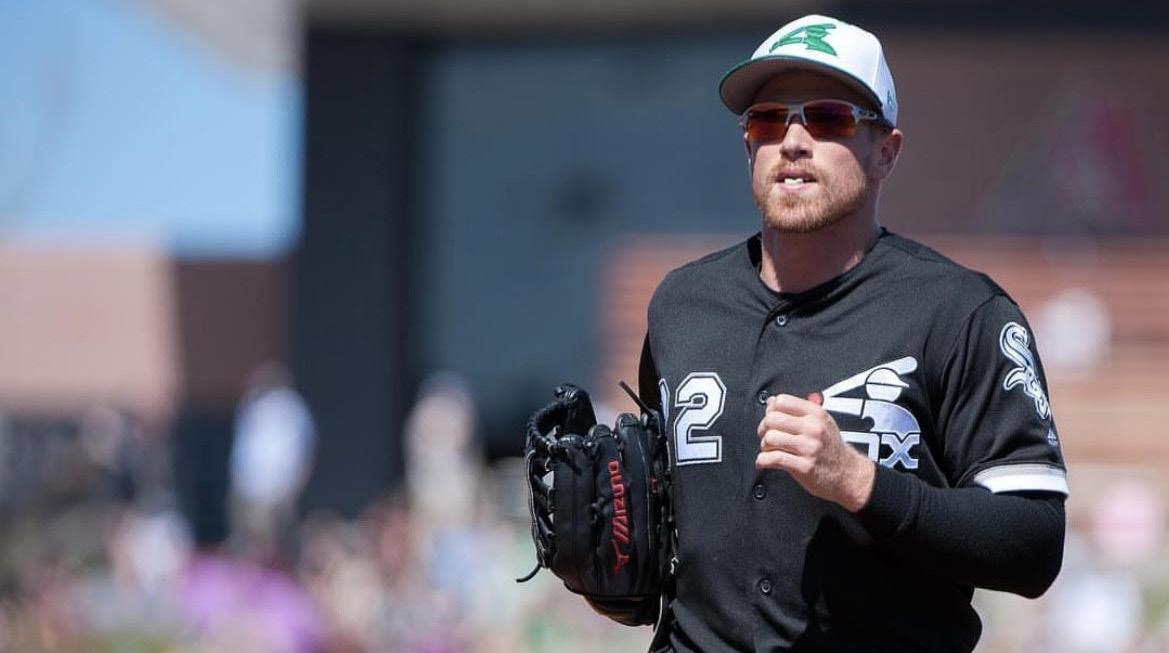
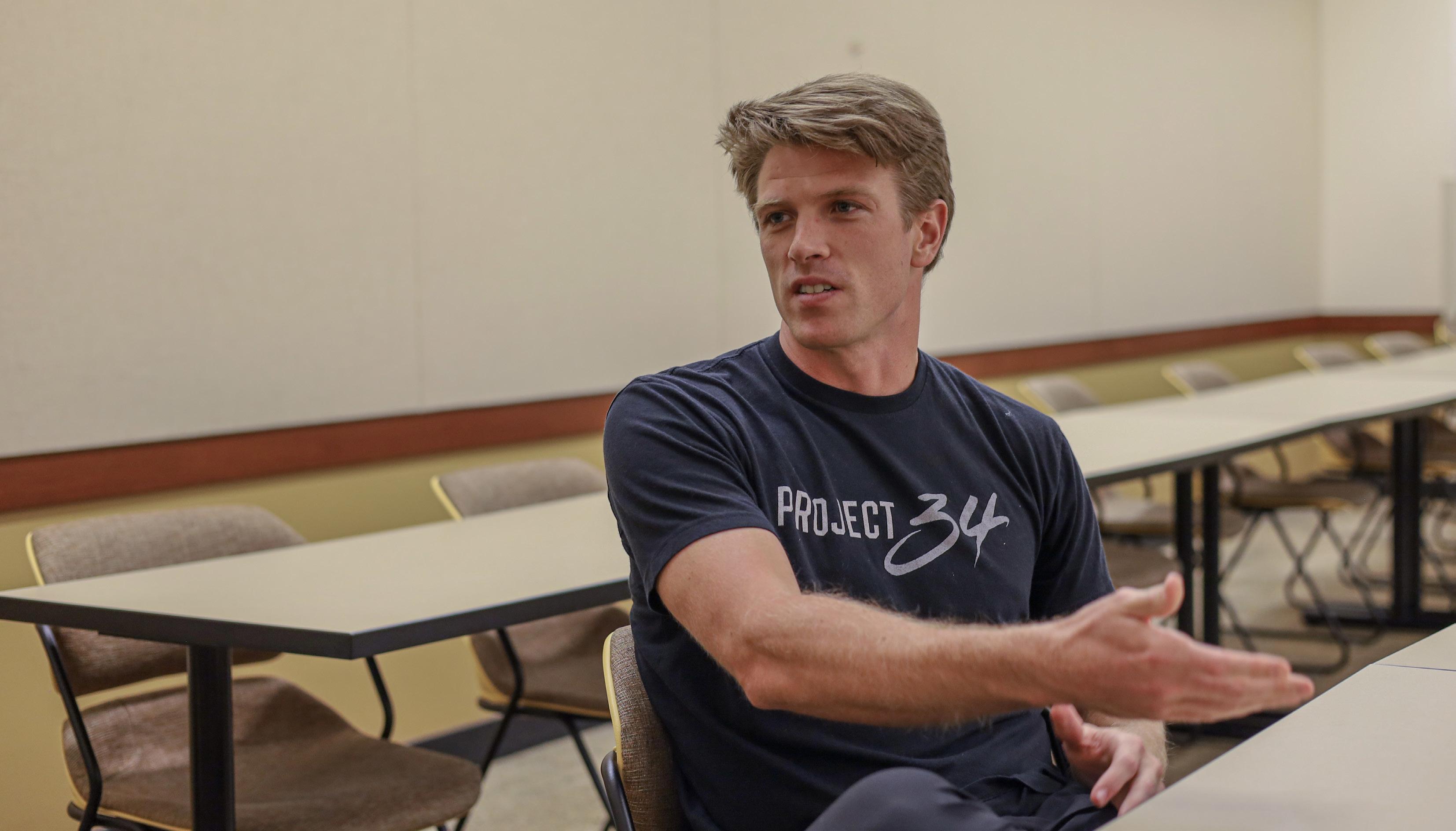
“It’s been really good,” Tilson said of his time at DePaul. “Growing up, I wasn’t really interested in school because I was focused on baseball … I feel like now that I’m older, it’s sort of allowed me to slow down a little bit and just read the directions and listen to the lectures and not cut corners in any way and obviously not cheat.”
Tilson admitted that he was not the best student in high school but acknowledged many have success in the classroom later on in life. He has enjoyed his time at DePaul, being back in the classroom and meeting new people.
When an athlete is drafted out of high school to Major League Baseball (MLB), their contract provides a College Scholarship Plan (CSP) or Continuing Education Program (CEP) that uses funds for attending an institution that offers training for personal and professional development. A CSP provision allows players to attend a university or college, as long as their studies are in pursuit of an undergraduate degree.
“Major League Baseball has like a scholarship program where if you’re drafted out of high school they’ll pay for you to go to school if you go back full-time within two years after getting released,” Tilson said. “I felt inspired being around some of the guys and I took some continuing studies classes at Northwestern initially, and I liked it.”
Tilson is taking sports reporting, taught by former Chicago Tribune Sports columnist Fred Mitchell, who is familiar with Tilson from his time with the Chicago White Sox. Students in Tilson’s class still cannot believe a former player is in their class.
“When I enrolled at DePaul for sports journalism, I did not expect to be peers with a professional athlete, let alone one that played for my favorite sports team on the planet,” DePaul senior Ethan Baca said. “I’m really glad to see he’s flipped the script for post-playing careers. From what I’ve seen in our class, he will have a seamless transition between professions.”
Transitioning from the diamond to the classroom has been fun for Tilson, especially since he is back home in Chicago and everyone knows who he is. A lot of students in his
classes have seen him on TV or are aware of his background in baseball.
“I think it’s really fun for me because for the most part, athletes want to be able to share their opinions and not get special treatment,” Tilson said. “It’s been really cool for me to interact with people who are big fans of baseball and seen major league baseball from a different perspective than I have over the last 10 years.”
Tilson, now 30, from New Trier high school was a 2011 second round pick, No. 79 overall of the St. Louis Cardinals. Once his high school career ended, Tilson had to make a choice between entering the MLB Draft or officially committing to a four-year scholarship to play at the University of Illinois.
The decision was simple for Tilson. He was going pro.
“In my mind, not close,” Tilson said of how close he was to playing college baseball. “I was just preparing my case to my mom and dad because if I got drafted in the first five rounds, I was going to get enough of an opportunity where I would find out if I was good enough to play in the big leagues.”
Tilson felt that college baseball’s exposure to being around great players was limited, especially in the Big Ten Conference, and from his perspective, going into the MLB Draft was a no-brainer.
He still wanted to remain loyal to his commitment and ended up seeking outside advice from an agent. His agent negotiated with team’s and established a certain number financially that it would take for him to sign with them instead of going to play at Illinois.
“At the advice of my agent, he told me to sit out the entire summer until the last day,” Tilson said. “He was certain, like we told
them in order to forgo a scholarship we want to do this, and in my mind, the moment I was drafted, it’s like dude just get me there, I want to make a positive impact.”
On July 31, 2016, the St. Louis Cardinals traded Tilson to the Chicago White Sox for right-handed pitcher Zach Duke. Not only was Tilson traded to his childhood favorite team, but he also was called up to make his debut with the club.
“It was my dream,” Tilson said. “I got a call from Rick Hahn, and he said I got you a plane ticket and you’re going to meet the team in Detroit. It was perfect and a lot of friends and family really understood my affiliation with the team and it was cool to share that.”
Tilson was expected to contribute immediately in the outfield, taking over for J.B. Shuck, and during his debut, he hit a single in his very first at bat against Tigers starter Aníbal Sánchez. Unfortunately, Tilson strained his left hamstring chasing down a fly ball in the outfield, which resulted in season-ending surgery two days later.
In 2017, Tilson was set to be an everyday starter for the White Sox, but another injury set him back. This time around, he suffered a stress reaction in the same foot, the second time he experienced the injury. He missed the entire 2017 season, his second-straight that resulted in a season-ending injury.
Tilson’s best moment in professional baseball came in 2019, when he hit a grand slam against the Houston Astros off Josh James to deep right field, his first and only career home run.
“I’ll never forget that moment because I knew it was coming,” Tilson said. “It was awesome and it really helped us win. That lineup was lethal and I had great teammates and
they knew that I wasn’t going to have a lot of them, so we celebrated it.”
Later that season, Tilson was designated for assignment and sent down to the minors to play for the Charlotte Knights, but instead asked for release from the team. Since his release, Tilson has played with the Pittsburgh Pirates, the Mexican league team the Acereros de Monclova, the independent team the Long Island Ducks, the Philadelphia Phillies and most recently another independent club, the Chicago Dogs.
Last season, Tilson appeared in 92 games for the Chicago Dogs, hitting for a .286 average with 5 home runs, 32 RBI and 20 stolen bases. He was released from the team on Feb. 3, 2023.
“He was our lead-off guy and center fielder,” team manager Butch Hobson said. “Love Charlie Tilson, he’s a class act and has a beautiful baby girl now. Really enjoyed my time with him and we were sorry to see him retire. That’s a tough decision to make when you’re a professional athlete, just to accept the fact that it’s over, but that’s part of the game.”
Hobson will forever admire and appreciate Tilson’s time with the ball club and will always be a fan of his.
“That man’s going to do well, whatever he does,” Hobson said. “He’s very smart and serious about his work. He’s a guy that’s played in the big leagues and independent ball. He’s worked his ass off because he wants to get picked up and try to get back into the big leagues.”
After retiring from professional baseball, Tilson spent time coaching with Northwestern’s team, and he has considered pursuing a career in coaching someday. It is required for most school’s at the Division I level to have a degree if they want to become a manager.
“My undergraduate degree is psychology, and my thought behind that initially was to use it to support coaching,” Tilson said. Now I’m considering doing a joint degree between psychology and communications. I want to stay in the realm of sports just because it’s second nature to me and I love it.”
Tilson will not close the door on a return to playing professional baseball, but for now, his focus is to be the best father and husband he can be and earn a degree at DePaul.
“If I get a phone call, I’ll go play [in the MLB] for sure,” Tilson said. “Unfortunately, I am retired from independent ball and I think it kind of goes back to wages and being away from my wife and family and not being able to make really any income, it’s just not possible.”
Big East coaching carousel: Where DePaul fits in
By Tom Gorski Sports EditorThe Big East is off to a strong start for the 2023- 24 season after UConn collected its fifth National Championship. Three head coaching changes have also been made, highlighted by St. John’s hiring Hall of Fame coach Rick Pitino to replace Mike Anderson.
Georgetown hiring Ed Cooley from Providence is the first time in Big East conference history that a head coach has left one conference team for another. Providence Athletic Director Steve Napolillo felt his mentor, Georgetown Athletic Director Lee Reed, conducted a hire that feels like a betrayal.
“College athletics is really at a crossroads because we talk about educating our student-athletes, and that all goes out the door on a lot of things,” Napolillo told Ian Steele of ABC6 in Rhode Island. “And for me at Providence College, to be in a room with my fellow colleagues where I felt a bond, where I felt a trust, where I felt that the athletic director was a mentor to me and a friend.”
Where DePaul stands
In November, Tony Stubblefield will enter his third year as head coach of the Blue Demons with a 25-39 overall record. He led the team to a 15-16 record his first season but saw a step backwards recently after the team went 10-23 in 2022-23, which included ending the regular season on a 12-game losing streak.

“I’m proud of these guys and their fight and being a resilient bunch,” Stubblefield said after the team’s quarterfinal loss to Xavier on March 9. “Dealing with all the injuries that we had and things that happened to our team, it wasn’t what we envisioned it to be over the course of the summer and even in the fall, but these guys really stuck with it.”
When Stubblefield took over for Dave Leitao in 2021, the hope was that the team would move forward, not backwards. But after the conclusion of this past season, DePaul still stands in the bottom of the conference.
Stubblefield and staff have a busy offseason ahead for recruiting after losing eight players to graduation and the transfer portal. The team is expected to have a few key players return which include Nick Ongenda, Jalen Terry, Caleb Murphy and Zion Cruz.
DePaul’s 2023 recruiting class is starting to shape up as well, featuring Minnesota transfer combo guard Jaden Henley, Triton JUCO junior transfer forward Keyondre Young, Olympus Prep 7-footer Babacar Mbengue and four-star NBA Academy Africa guard Dramane Camara.
Henley, a three star recruit coming out of Colony High School in Ontario, California appeared in 31 games for the Gophers this past season, starting in 18. He averaged 5.3 points, 2.2 rebounds and 1.3 assists per game, while shooting 37.8% from beyond the arc.
Babacar was ranked as the No. 19 center in the 2023 class by 247sports.com and is a native of Senegal, where he played with the national team in the 2020 FIBA U18 African Championship.
“Babacar [Mbengue] is a really talented young player with an incredible amount of potential,” Stubblefield said. “He has developed a lot over the last year or so and we are looking forward to getting him on campus and continuing his growth. He is a strong physical presence inside and has a desire to keep learning.”
Young played in 25 games in 2022-23 for Triton with 16 starts, averaging 10.7 points, 4.9 rebounds and 1.7 assists per game, while shooting 40.1% from the field and 31% from beyond the arc. His best performance of the season was on Feb. 2 against Harry S. Truman College where he scored 25 points and made seven 3-pointers.
“We’re really excited to add Keyondre [Young] next season,” Stubblefield said. “Our staff really values the experience junior college players can bring to our roster and Keyondre
is no different.”
Pitino hired at St. John’s
Perhaps the biggest splash of the coaching carousel is St. John’s hiring Hall of Fame head coach Rick Pitino to a six-year deal in the neighborhood of $20 million with the Red Storm.
The hiring of Pitino could shake up the landscape of the Big East, but St. John’s is not entering a rebuild according to Dave Berov, host of the Eye on the Storm podcast. The motivation behind hiring Pitino is likely to win right away, raising expectations for the program immediately.
“The expectation right now should be to make the tournament,” Berov said. “Rick Pitino was at Louisville from 2001-2016. In that time, I believe he missed the tournament only three times and one of those times was when he was on a self imposed ban... Rick Pitino doesn’t miss the NCAA Tournament, it just doesn’t happen.”
Pitino has turned around every program he has ever been a part of and as soon as he arrives, the program immediately becomes competitive. He has taken four different teams to the NCAA tournament and coached two national championship teams. During his 32 seasons as head coach, Pitino has a 770271 (74%) overall record and a 54-19 (80%) record in the NCAA Tournament.

“He’s not wasting time, this is not a rebuilding project,” Berov said. “This is a restocking and he’s going after kids who he knows will fit what he is looking for.”
Cooley leaves Providence for Georgetown
In an unconventional in-conference move, Georgetown poached Ed Cooley from
its inter-conference opponent Providence, hiring Cooley to replace NBA Hall of Famer Patrick Ewing.
“I’m incredibly grateful for every opportunity that’s ever been given,” Cooley said during his introductory press conference. “We’re gonna lose some games, it’s okay, losing is part of growth. But over time, it’s gonna pay off, and the dreams do come true. It was a dream of mine to be here.
Cooley spent 11 seasons with Providence, finishing with a record of 221-141 and leading the Friars to six NCAA Tournament appearances. Cooley won the 2021-22 Naismith Coach of the Year Award and has turned around both the Fairfield University’s program and now Providence as well.
English takes over at Providence
After the unexpected departure of Cooley, Napolillo hired George Mason head coach Kim English to a six-year deal to be the team’s next coach. English, 34, is set to be the youngest head coach in the Big East Conference.
Prior to his short stint at George Mason, English was the assistant to Rick Barnes at Tennessee from 2019-21. The Volunteers made the NCAA Tournament two of the three seasons English was there, and he played a pivotal role in helping develop NBA talents like Keon Johnson and Grant Williams.
According to FoxSports’ John Fanta, the Providence program was impressed with English’s recruiting acumen, leadership and the prospect of hiring one of the industry’s rising stars.
DePaul’s significant coaching turnover
Since joining the Big East conference in
2005, DePaul has finished .500 twice and seen just one season reach 20 wins. During that span, the basketball program has had an underwhelming overall record of 148-256.
The basketball program has visibly struggled with Athletic Directors Jean Lenti Ponsetto (2002-20) and DeWayne Peevy (2020-present). During that span, the program has experienced an inability to find stability at head coaching position that has resulted in five different hires, while also struggling to find a path to bringing the program back to relevance in the third largest market in the country.
Some major issues regarding DePaul’s lack of success include a small budget and an inability to attract top-level talent. According to 247Sports, DePaul’s biggest recruiting class came in 2005, when the program landed fourstar recruits Rashad Woods and 14-year NBA veteran Wilson Chandler.
In 2015, DePaul’s head coaching search involved names such as Bobby Hurley and Bryce Drew, but Ponsetto opted to re-hire Dave Leitao instead, who served as the team’s head coach from 2002-2005.
Hurley was hired by Arizona State in 2015 and since, has led the Sun Devils to three NCAA Tournament appearances and an overall record of 141-113. During his time in Tempe, Hurley has been able to land one five-star recruit and 14 four-star recruits according to 247Sports.
How is DePaul Affected?
DePaul has struggled finding success since arriving in the Big East and with Rick Pitino, Kim English and Ed Cooley present, recruiting could become more difficult for Stubblefield and the Blue Demons.
The team has lost a lot this offseason and replacing multiple starters is likely to be no easy task and with the new coaching additions. Recruiting could also become much more complicated because many in the Big East usually target the same recruits and go through the same process.
Throughout his career, Pitino has shown an ability to land top recruits. If DePaul and St. John’s target is the same player, it will be a challenge for the Blue Demons to compete.
“I think bringing in Pitino though makes everyone stand up,” Berov said. “They know who they’re recruiting against and Pitino is a great recruiter. He could pretty much convince anyone to come play for him.”
There is still a long offseason, but with the increasing pressure on Stubblefield to win, next season could be a make-or-break year for not only him. The team has not seen tangible success since 2004 and has gone through two athletic directors and five head coaches since its last NCAA Tournament appearance.
Sports
No more Morrow: Star leads exodus of Demons to portal
By Preston Zbroszczyk Asst. Sports EditorFor DePaul women’s basketball, a 1617 record and a heartbreaking loss in the Big East Tournament was not part of the plan, but the future looked brighter for the upcoming 2023-24 season.


That was until Wednesday when two Chicago natives, sophomore All-American Aneesah Morrow and junior AllBig East Second Team Darrione Rogers placed their names into the transfer portal, shocking the DePaul and college basketball community.
Rogers and Morrow combined for 42.5 points per game this season, which was more than half of the team’s average scoring total of 76 points per game.
Morrow averaged a double-double in both seasons and led the team in scoring in her freshman and sophomore years. Rogers had her biggest jump in her production from 9 points a game in her sophomore year to 16 in her junior season. She also had the program’s sixth triple-double this season.
According to MaxPreps, Morrow was ranked the No. 1 player in the state of Illinois and 20th in the country as a high school senior when she led Simeon Career Academy to its first state championship and achieved All-State First Team honors.
Rogers played at Lake Park West High School and was considered an ESPN top-50 recruit in the top-100 in 2020. She, like Morrow, was a state champion and a two-time All-State guard.
Landing a talent like Morrow after having Rogers already committed the year before and keeping them close to home was unheard of at DePaul in recent years. After seeing what Morrow did in her first month of her freshman season, and Rogers growth, the combination of talent and head coach Doug Bruno’s winning ways, was supposed to serve for many winning seasons.
In a statement to The DePaulia from DePaul Athletics, it addressed the surprising news about the two best players on the team and their decisions.
“We appreciate all the hard work and dedication both have given DePaul University and the women’s basketball program,” DePaul athletics said. “We support them in whatever decisions they and their families believe are best for them in the future.”
Following the statement’s release, the Athletic department allowed no further comments or interviews to be conducted with players, or staff.
Junior Kendall Holmes, who was the team’s third leading scorer and had the teams highest three point percentage, told The DePaulia she also entered her name in the transfer portal, but did not want to comment.
Since the mid 1990’s Bruno has had the winningest teams in DePaul history. They have maintained the local talent from Chicago and have appeared in 25 NCAA Tournaments. What has changed. The first losing season in over 15 years, lost its top three scorers in one season, is it time to panic for the program?
Former DePaul player in the 2017-18 season, Rachel McLimore, who transferred from the program after just one season, and is currently playing for Butler University, said she just wanted to be closer to home.
“I had a great experience at DePaul,” McLimore said. “Great coaches that treat you the right way and a great environment to play in. I was actually very curious as to why so many people are leaving now too. Bruno is an amazing coach and I learned a lot from him in the year I was there.”
Keke Rimmer, who played with Rogers and Morrow said the lack of winning recently had nothing to do with them leaving.
Rimmer, who played four seasons at DePaul, said she built a stronger relationship with the two girls and is excited for what their future holds.
“I don’t think that [not winning] played into their decision making,” Rimmer said. “But I do think everyone loves to win. Knowing them personally, I think it was something they thought about long and hard about while factoring in difficult components. Transferring isn’t easy, and starting over isn’t easy.”
Rimmer herself, announced on her Instagram on April 6, that she would be playing her graduate fifth year at University of Illinois at Chicago, making her the third player in a matter of days to leave the program.
Since the 2017-18 season, 11 players have now transferred out of the DePaul women’s Basketball program. Four of them are from the Illinois and Chicago area.
Prior to the start of the 2022-23 season, Morrow told The DePaulia, “I chose DePaul because a lot of star athletes considering I was the No.1 player in the state leave the state or their city. So I want to stay here. I didn’t want to go far away from home. This is a great choice for me.”
In women’s college basketball being able to declare for the WNBA draft isn’t the same for the NBA. Players must be 21 years old, or older to enter their names. Although there are no restrictions for overseas players to enter the WNBA draft, there are stricter age restrictions. Meaning getting the chance to play four years and appear in an NCAA Tournament is where you get your name noticed.
For the two seasons that Bruno had Rogers and Morrow on his roster, the duo never appeared in the NCAA Tournament. They got as close as the First Four of the tournament, which is a playin game to get you into the actual tournament, when they lost 88-57 to Dayton, on March 16, 2022.
Bruno, approaching his 38th season, at the age of 72, will have a challenge ahead of him to get this team back to
where it expects to be.
Throughout the season and the many losses, there was visual frustration within the team.
Multiple times throughout the year following a loss, Bruno wouldn’t bring out Morrow, Rogers or any player out for press conferences to speak on the loss.
Since 2019, DePaul is 38-28 with only one Big East Tournament win and a combined conference record of 22-18.
Morrow and Rogers’ departures caused roadblocks for the following season of DePaul women’s basketball. This not only impacts the current roster, but also future recruits, and possibly calls into question the current state of DePaul’s program.
